GemTek Technology AP931229AG Dual Band Outdoor Access Point User Manual
Gemtek Technology Co., Ltd. Dual Band Outdoor Access Point Users Manual
Contents
- 1. Users Manual
- 2. Manual
Users Manual

54Mb Dual-Band Outdoor AP
Gemtek System P-780
User’s Guide v1.2
Copyright © 2002-2004 Gemtek Systems Holding BV
www.gemtek-systems.com

Gemtek Systems Page 3 of 60
Copyright
© 2002-2005 Gemtek Systems Holding BV.
This user’s guide and the software described in it are copyrighted with all rights reserved. No part of
this publication may be reproduced, transmitted, transcribed, stored in a retrieval system, or translated
into any language in any form by any means without the written permission of Gemtek Systems
Holding BV.
Notice
Gemtek Systems reserves the right to change specifications without prior notice.
While the information in this manual has been compiled with great care, it may not be deemed an
assurance of product characteristics. Gemtek Systems shall be liable only to the degree specified in
the terms of sale and delivery.
The reproduction and distribution of the documentation and software supplied with this product and
the use of its contents is subject to written authorization from Gemtek Systems.
Trademarks
The product described in this book is a licensed product of Gemtek Systems Holding BV.
Microsoft, Windows 95, Windows 98, Windows Millennium, Windows NT, Windows 2000, Windows
XP, and MS-DOS are registered trademarks of the Microsoft Corporation.
Novell is a registered trademark of Novell, Inc.
MacOS is a registered trademark of Apple Computer, Inc.
Java is a trademark of Sun Microsystems, Inc.
Wi-Fi is a registered trademark of Wi-Fi Alliance.
All other brand and product names are trademarks or registered trademarks of their respective
holders.

Gemtek Systems Page 4 of 60
Within the 5.15 to 5.25 GHz band (5GHz radio channels 34 to 48) the U-NII devices
are restricted to indoor operations to reduce any potential harmful interference to
MSS operations.
FCC Warning
FCC Interference Statement
This equipment has been tested and found to comply with the limits for a Class B digital device,
pursuant to Part 15 of the FCC Rules. These limits are designed to provide reasonable protection
against harmful interference in a residential installation. This equipment generates, uses and can
radiate radio frequency energy and, if not installed and used in accordance with the instructions, may
cause harmful interference to radio communications. However, there is no guarantee that interference
will not occur in a particular installation. If this equipment does cause harmful interference to radio or
television reception, which can be determined by turning the equipment off and on, the user is
encouraged to try to correct the interference by one of the following measures:
Reorient or relocate the receiving antenna.
Increase the separation between the equipment and receiver.
Connect the equipment into an outlet on a circuit different from that to which the receiver is
connected.
Consult the dealer or an experienced radio/TV technician for help.
This device complies with Part 15 of the FCC Rules. Operation is subject to the following two
conditions: (1) This device may not cause harmful interference, and (2) this device must accept any
interference received, including interference that may cause undesired operation.
FCC Caution
Any changes or modifications not expressly approved by the party responsible for compliance could
void the user's authority to operate this equipment.
FCC Radiation Exposure Statement
This equipment complies with FCC radiation exposure limits set forth for an uncontrolled environment.
This equipment should be installed and operated with minimum distance 20cm between the radiator &
your body.
If this device is going to be operated in 5.15 ~ 5.25GHz frequency range, then it is restricted in indoor
environment only.
This transmitter must not be co-located or operating in conjunction with any other antenna or
transmitter.
Gemtek Systems declares that P-780 ( FCC ID: MXF-AP931229AG ) is limited in
CH1~CH11 for 2.4GHz by specified firmware controlled in U.S.A

Gemtek Systems Page 5 of 60
IC Warning
Operation is subject to the following two conditions:
This device may not cause interference and
This device must accept any interference, including interference that may cause undesired
operation of the device
This device has been designed to operate with an antenna having a maximum gain of 8 dBi.
Antenna having a higher gain is strictly prohibited per regulations of Industry Canada. The required
antenna impedance is 50 ohms.
To reduce potential radio interference to other users, the antenna type and its gain should be so
chosen that the EIRP is not more than required for successful communication.
Because high power radars are allocated as primary users (meaning they have priority) in 5250-5350
MHz, these radars could cause interference and/or damage to license exempt LAN devices.

P-780 User’s Guide v1.2 February 7, 2005
Gemtek Systems Page 6 of 60
Copyright .............................................................................................................................................3
Notice ..................................................................................................................................................3
Trademarks .........................................................................................................................................3
FCC Warning.......................................................................................................................................4
IC Warning ..........................................................................................................................................5
CONTENTS ............................................................................................................................................6
ABOUT THIS GUIDE..............................................................................................................................8
Purpose ...............................................................................................................................................8
Prerequisite Skills and Knowledge......................................................................................................8
Conventions Used in this Document...................................................................................................8
Help Us to Improve this Document! ....................................................................................................8
Gemtek Systems Technical Support...................................................................................................8
CHAPTER 1 – INTRODUCTION............................................................................................................9
Product Overview................................................................................................................................9
Features Highlight .............................................................................................................................10
CHAPTER 2 - INSTALLATION............................................................................................................11
The Product Package........................................................................................................................11
Hardware Introduction.......................................................................................................................12
General Overview ..........................................................................................................................12
Bottom Cover.................................................................................................................................13
LEDs ..............................................................................................................................................13
RF Connectors...............................................................................................................................14
Hardware Installation.........................................................................................................................15
Installing the Access Point.............................................................................................................15
Connect to the Power Source and Local Network.........................................................................16
Software Installation..........................................................................................................................17
Initialization ....................................................................................................................................17
Software Introduction: KickStart ....................................................................................................17
Access Your P-780 ........................................................................................................................17
CHAPTER 3 – APPLICATION MODE .................................................................................................21
AP + Bridge Mode .............................................................................................................................21
AP + AP Mode...................................................................................................................................21
Bridge+ Bridge Mode ........................................................................................................................22
CHAPTER 4 – REFERENCE MANUAL...............................................................................................23
Web Interface....................................................................................................................................23
Status ................................................................................................................................................24
Status | Device Status ...................................................................................................................24
Status | Wireless Status.................................................................................................................24
Network .............................................................................................................................................25
Network | Interface.........................................................................................................................25
Network | RADIUS Server .............................................................................................................27
Network | DHCP Settings ..............................................................................................................28
Wireless.............................................................................................................................................33
Wireless | Basic .............................................................................................................................33
Wireless | Advance ........................................................................................................................37
Wireless | WEP..............................................................................................................................41
Wireless | MAC ACL ......................................................................................................................42
Contents

P-780 User’s Guide v1.2 February 7, 2005
Gemtek Systems Page 7 of 60
System...............................................................................................................................................45
System | Security...........................................................................................................................45
System | SNMP..............................................................................................................................45
System | Telnet..............................................................................................................................47
System | Configuration ..................................................................................................................47
System | Reset...............................................................................................................................49
System | Upgrade ..........................................................................................................................49
APPENDIX............................................................................................................................................51
A) Specification .................................................................................................................................51
B) Factory Defaults for the P-780......................................................................................................53
C) Regulatory Domain/Channels/Power ...........................................................................................53
D) Approved Antenna........................................................................................................................55
E) Waterproof Tape Application Example.........................................................................................56
F) Location ID and ISO Country Codes ............................................................................................58
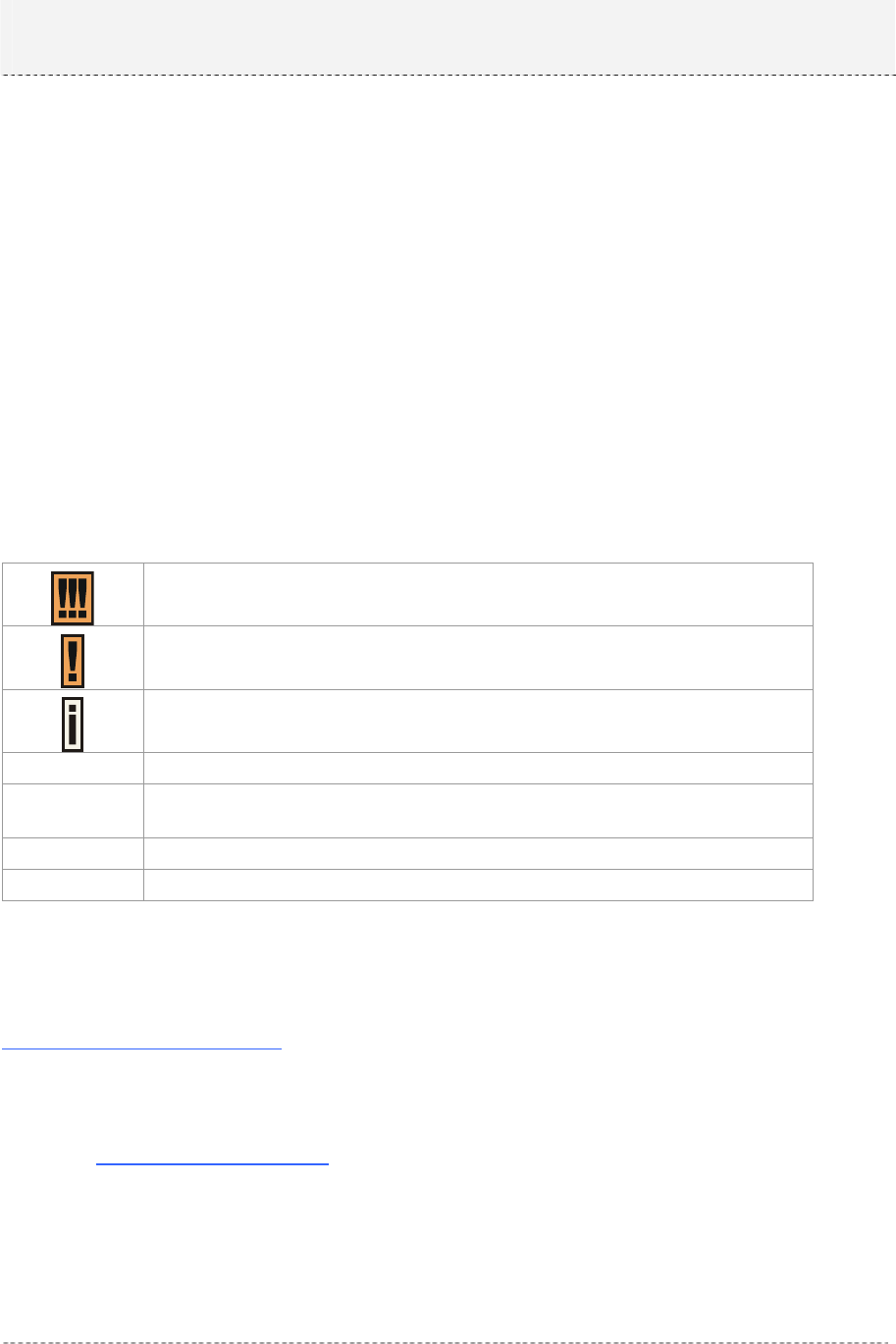
P-780 User’s Guide v1.2 February 7, 2005
Gemtek Systems Page 8 of 60
Purpose
This document provides information and procedures on hardware installation, setup, configuration,
and management of the Gemtek Systems high performance 54Mb Dual-Band Outdoor AP P-780.
Prerequisite Skills and Knowledge
To use this document effectively, you should have a working knowledge of Local Area Networking
(LAN) concepts and wireless Internet access infrastructures. In addition, you should be familiar with
the following:
Hardware installers should have a working knowledge of basic electronics and mechanical
assembly, and should understand related local building codes.
Network administrators should have a solid understanding of software installation procedures for
network operating systems under Microsoft Windows 95, 98, Millennium, 2000, NT, and Windows
XP and general networking operations and troubleshooting knowledge.
Conventions Used in this Document
The following typographic conventions and symbols are used throughout this document:
Very important information. Failure to observe this may result in damage.
Important information that should be observed.
Additional information that may be helpful but which is not required.
bold Menu commands, buttons and input fields are displayed in bold
code File names, directory names, form names, and system-generated output
such as error messages are displayed in constant-width type
<value> Placeholder for certain values, e.g. user inputs
[value] Input field format, limitations, and/or restrictions.
Help Us to Improve this Document!
If you should encounter mistakes in this document or want to provide comments to improve the
manual please send e-mail directly to:
manuals@gemtek-systems.com
Gemtek Systems Technical Support
If you encounter problems when installing or using this product, please consult the Gemtek Systems
website at www.gemtek-systems.com for:
Direct contact to the Gemtek Systems support centers.
Frequently Asked Questions (FAQ).
Download area for the latest software, user documentation and product updates.
About this Guide

P-780 User’s Guide v1.2 February 7, 2005
Gemtek Systems Page 9 of 60
Thank you for choosing the Gemtek Systems High Performance Dual-Band Outdoor Access Point P-
780.
The Gemtek Systems P-780 operates simultaneously in the 5-GHz and 2.4-GHz frequency bands and
is fully compliant to 802.11b/g and 802.11a standard with its high performance and enhanced security.
P-780 is an important part for the Gemtek Systems HotZone solution as 11a/b/g outdoor AP.
The two Dual-Band radio (a/g + a/g) that this product provides supplies the furthest in flexibility and
makes sure low interference and large coverage. The a+g operation mode and Multiple BSSID that
this product provides differentiates it from traditional outdoor AP product.
Product Overview
Flexibility and high performance
The Gemtek Systems P-780 is a high performance outdoor AP for HotZone service. The two Dual-
Band radios and AP/Bridge operation mode supply the furthest flexibility for wireless applications:
z Simultaneously supports 802.11a/b/g in one platform
z Mix AP and Bridge mode configuration work simultaneously, blanketing last mile with high-speed
bandwidth
z Dual AP configuration for high client density environment
z Dual Bridge configuration for wireless repeating and wireless bridging areas
Secure and reliable wireless networking
The Gemtek Systems P-780 supplies multiple methods to protect the wireless network:
z Supports VLAN, up to 16 VLAN ID
z IEEE 802.1x/EAP with password, certificates and SIM card
z 64bits/128bits static and dynamic WEP key
z Supports Wi-Fi Protected Access(WPA)
z Layer 2 Isolation for preventing snooping under the same radio
z MAC ACL for preventing illegal attacking from Internet
Multiple BSSID
Supports up to16 BSSID, each of BSSID can be configured independently such as using different
SSID, security, authentication method, and VLAN ID.
Management Option
You can use the Access Controller management systems through the following interfaces:
Web-browser interface
with HTTPS
Command Line interface (CLI) with optional SSH
Simple Network Management Protocol
Chapter 1 – Introduction

P-780 User’s Guide v1.2 February 7, 2005
Gemtek Systems Page 10 of 60
P-780 management system pages are organized the same way for the web-browser interface and the
CLI. This user manual provides detailed description of each management option.
Features Highlight
Super Brige
802.11a/b/g compliant
108Mbps raw data rate supporting
Up to 20 bridge links supporting
Special radio for Bridge
WPA/PSK over Bridge link
Super AP
Multiple BSSID (up to 16)
SSID per BSSID
Enabled or Disabled Hidden SSID per BSSID
VLAN ID per BSSID
AAA way per BSSID, 802.1x and web login
Co-existence of 802.1x and web login
Security policy per BSSID
WPA passthrough
RADIUS server per BSSID
AAA
RADIUS client supporting
802.1x supporting(EAP/TLS,EAP/TTLS, EAP/PEAP and EAP/SIM)
Security
Static 64/128bits WEP, Dynamic 64/128bits WEP
WPA/TKIP and WPA/AES support
MAC ACL
Access Control (accept rule and deny rule) based on MAC address
Layer 2 Isolation
Hidden SSID
Management
Secure management via HTTPS, CLISH, SNMP
Standard MIB and Gemtek Systems Private MIB
Remote firmware update via WEB UI
Backup/Restore configuration file
DHCP Server

P-780 User’s Guide v1.2 February 7, 2005
Gemtek Systems Page 11 of 60
This chapter provides installation instructions for the hardware and software components of the
Access Point P-780. It also includes the procedures for the following tasks:
Hardware Introduction (LEDs, Connectors)
Connecting the Access Point
First Configuration
The Product Package
The product comes with the following:
Dual-Band outdoor Access Point (model: P-780)
Mounting Kit
Screw Bag for Mounting Kit
Waterproof tape
Omni-directional antenna ( A-807) * 2
Installation CD containing:
P-780 User Guide in PDF format
KickStart Utility
Product Firmware
Release Notes
Adobe Acrobat Readers
Readme
Printed 1 Year Warranty Card
Printed Release Note
Printed Warning Card
If any of these items are missing or damaged, please contact your reseller or
Gemtek Systems sales representative.
A-807 antenna is the accessory of P-780 Product.
Refer to the Appendix D for A-807 Antenna Spec: D) Approved Antenna
The application example of waterproof tape can be referred to the Appendix E:
E) Waterproof Tape Application Example
Chapter 2 - Installation
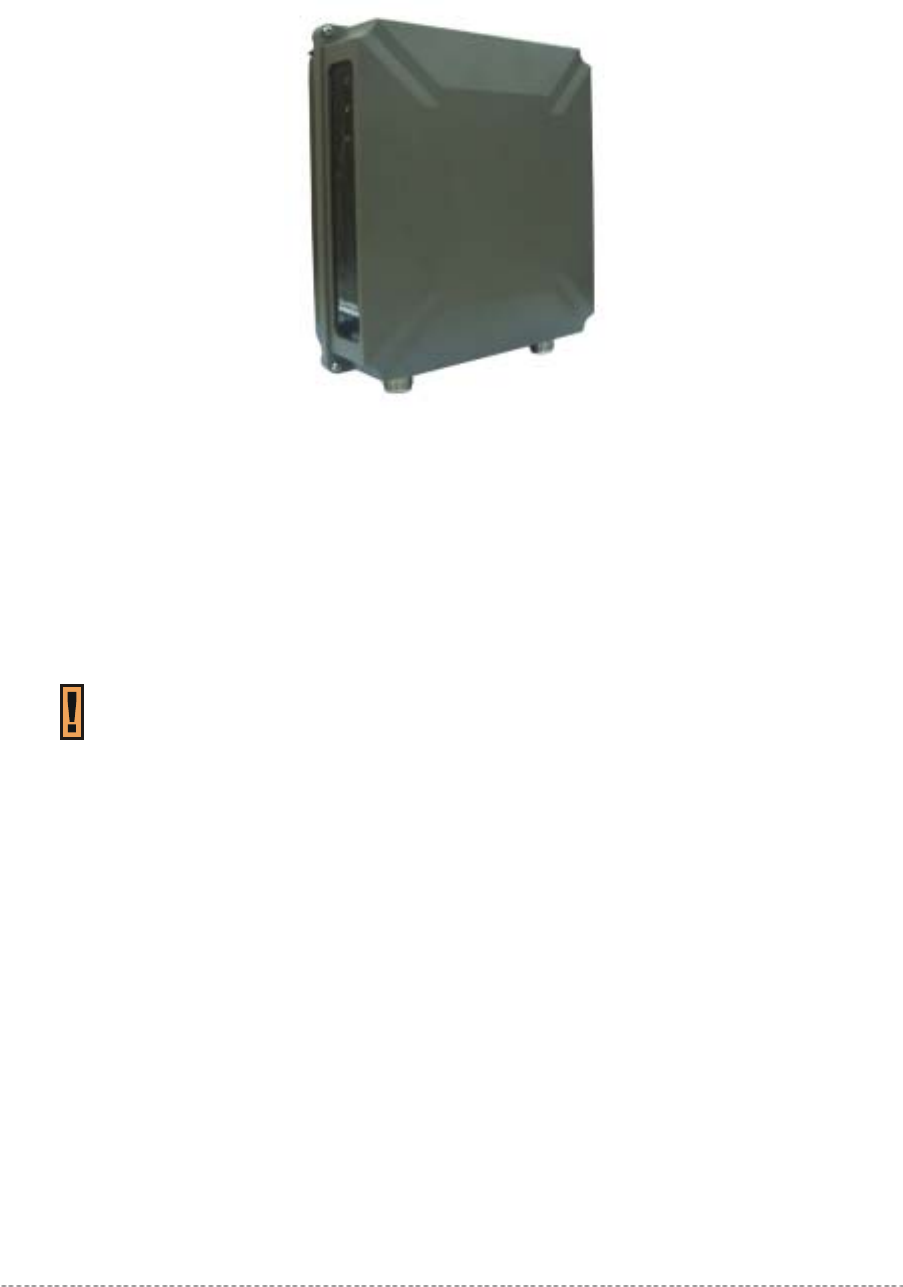
P-780 User’s Guide v1.2 February 7, 2005
Gemtek Systems Page 12 of 60
Hardware Introduction
General Overview
Figure 1 – P-780 General View
The front panel of P-780 contains:
There are 3 indicator lights (LEDs) that help to describe the state of various networking and
connection operations.
The Bottom cover of P-780 contains:
Connectors which enable you to make different network connections for the device
Reset button enables you to reboot or reset the device configuration to the factory defaults
Press the Reset button for less than 5 seconds to reboot the device.
Press the Reset button for more than 5 seconds to set the device to factory
defaults.
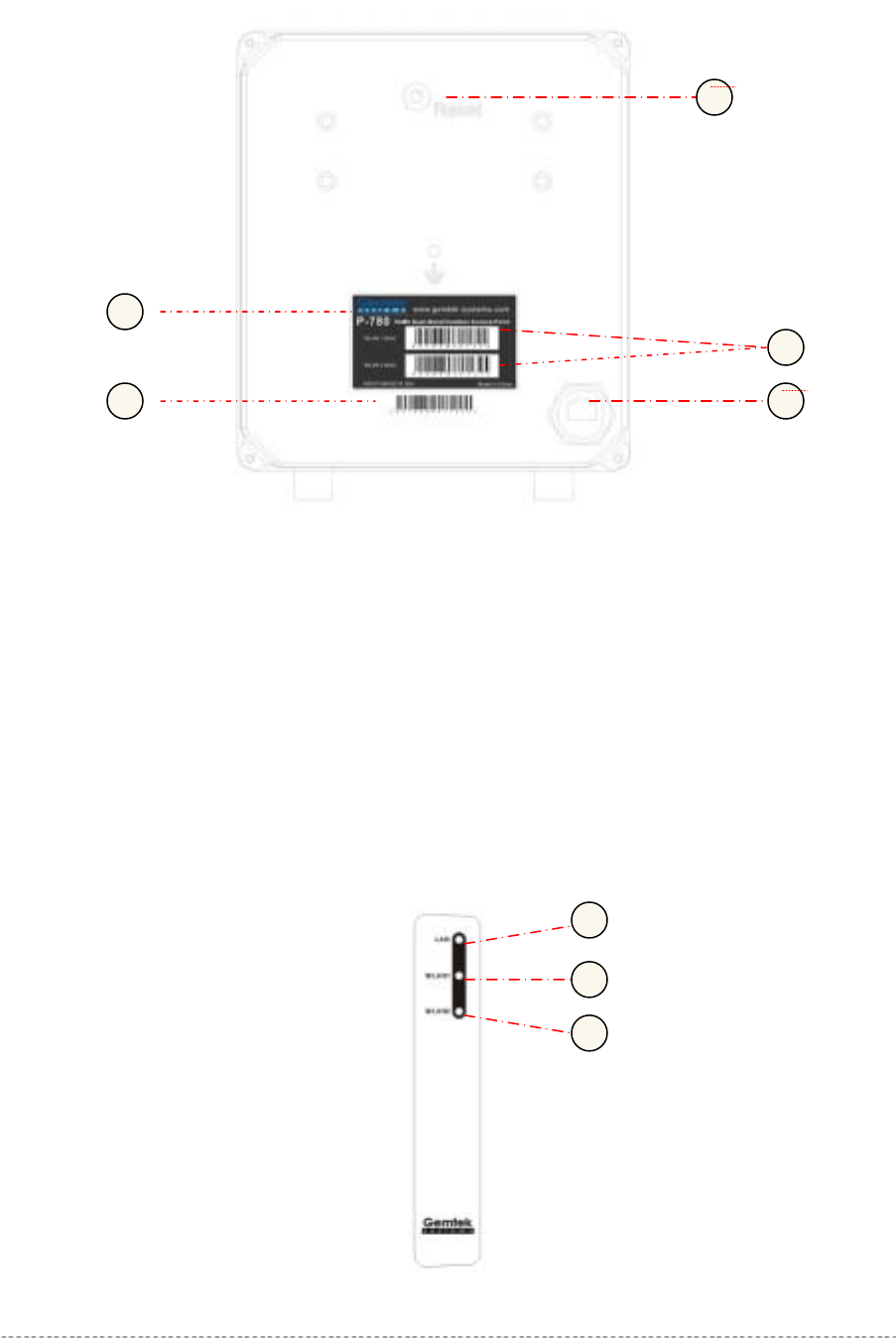
P-780 User’s Guide v1.2 February 7, 2005
Gemtek Systems Page 13 of 60
Bottom Cover
Figure 2 –Bottom Cover of the P-780
The Bottom Cover of the P-780 contains:
1. Back Label with Model and Device name. The official device name is 54Mb Dual-Band Outdoor
Access Point, model P-780.
2. MAC address labels of the device. The two labels show the WLAN1 and WLAN2 interface MAC
address of the device.
3. Serial Number label of the device.
4. LAN Port. It is a waterproof RJ45 connector.
5. RESET Button. It is covered by a M5 Screw with a waterproof rubber washer
LEDs
The P-780 Access Point has 3 LEDs located on the front panel:
Figure 3 – LEDs of the P-780
2
1
3
1
2
3
4
5

P-780 User’s Guide v1.2 February 7, 2005
Gemtek Systems Page 14 of 60
The various states of the LEDs indicate different networking and connection operations as follows:
Item LED Color Status Indication
On P-780 Ethernet Port Link Active 1 LAN Green
Blink P-780 Ethernet Port is Transmitting
and Receiving data
On P-780 WLAN1 RF card Active 2 WLAN1 Green
Blink P-780 WLAN1 RF card is Transmitting
and Receiving data
On P-780 WLAN2 RF card Active 3 WLAN2 Green
Blink P-780 WLAN2 RF card is Transmitting
and Receiving data
RF Connectors
The P-780 has 2 N-type RF connectors on the flank panel:
Figure 4 –RF Connectors
Descriptions of the connectors are given in the following table:
Item Connector Description
1 WLAN1 For WLAN1 RF card connecting to Antenna
2 WLAN2 For WLAN2 RF card connecting to Antenna
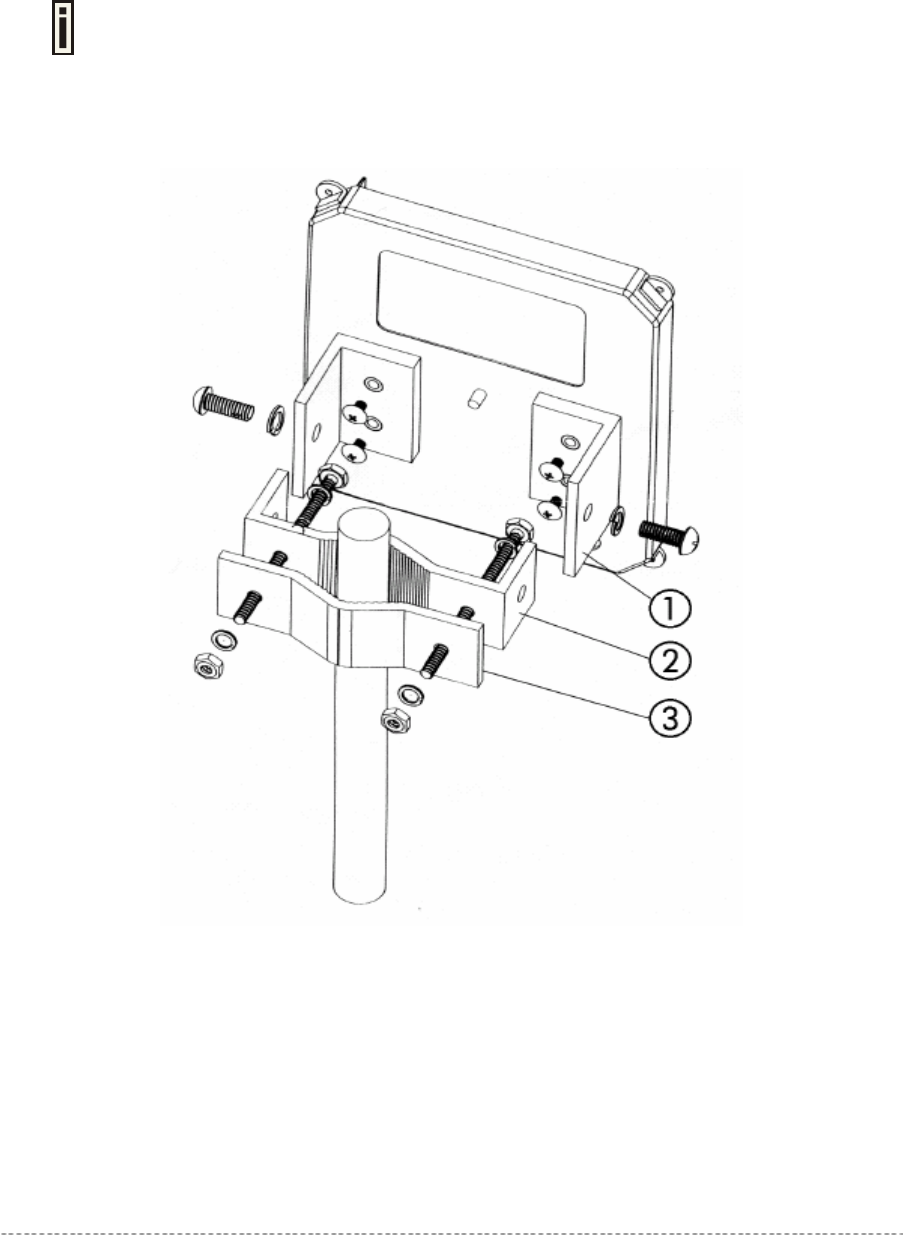
P-780 User’s Guide v1.2 February 7, 2005
Gemtek Systems Page 15 of 60
Hardware Installation
Installing the Access Point
Use the following procedure to prepare your network connection to P-780.
Use the enclosed POE and power cord or any others IEEE802.3af Compliant POE
Power Source Devices to supply your P-780 Access Point.
Step 1 Assemble part 1 of the Mount Kit at the back of the bottom cover as shown in the following
figure:
Figure 5 – Assembling the Mounting Kit to the P-780
Step 2 If you are mounting the AP on the wall, first install the bracket 2 of the mounting kit to a
suitable position. Assemble the back of the P-780 case to the bracket ubsequently.
Step 3 If you are mounting the AP to a mast, first install the bracket 2 and the clip 3 of the
Mounting to a mast. Assemble the back of the P-780 case to the bracket subsequently
Step 4 Assemble the one side of a Ethernet twist cable with the waterproof RJ45 connector .
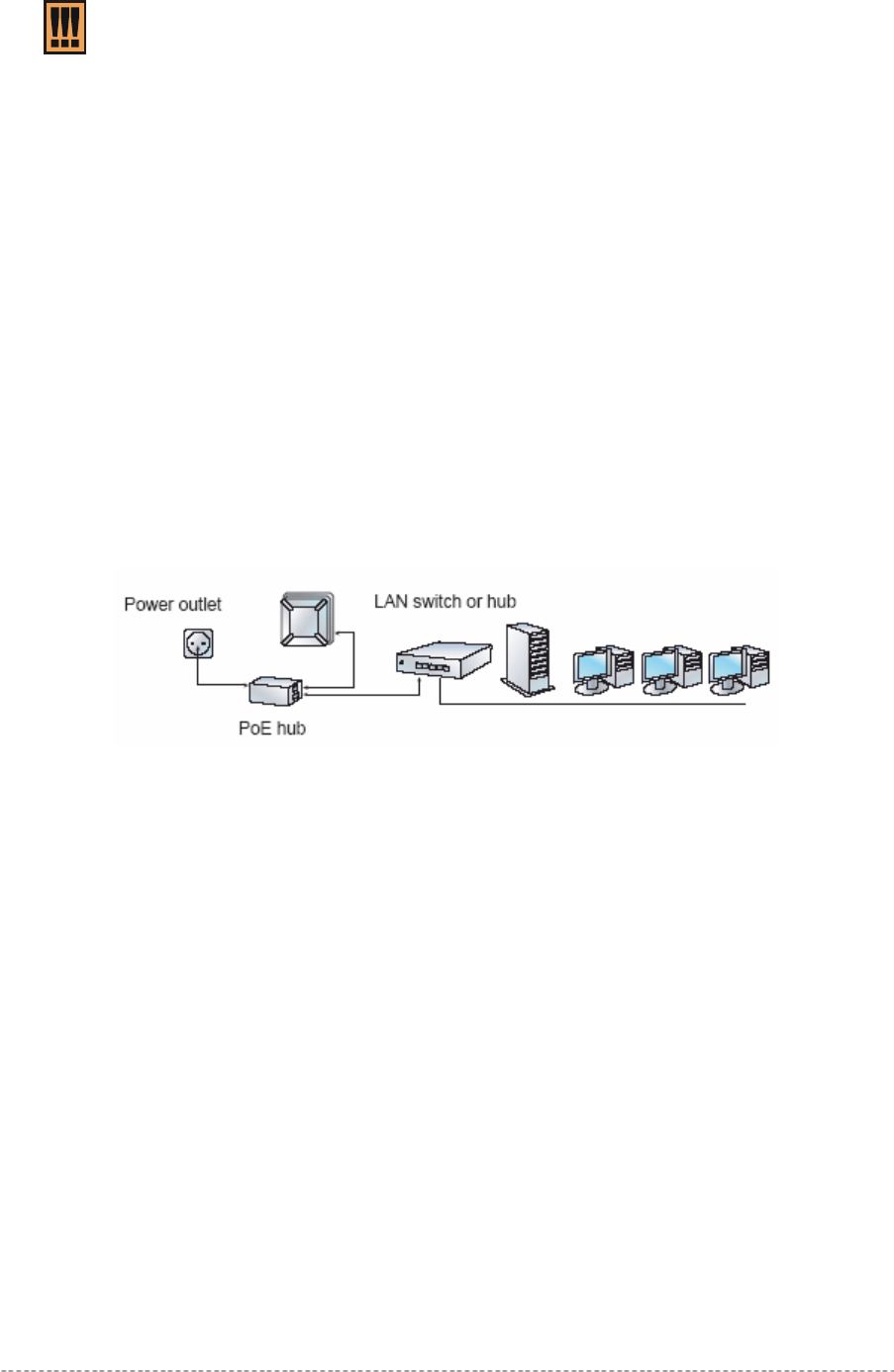
P-780 User’s Guide v1.2 February 7, 2005
Gemtek Systems Page 16 of 60
Please read the description sheet in Waterproof RJ45 Connector package carefully
before you do the assembly.
Step 5 Insert the the Ethernet twist cable to the LAN port connector on the back of the P-780
Bottom Cover and screw down the nut.
Step 6 Connect two RF connectors to the Antennas by Jump RF cable with waterproof N-type
plug.
Connect to the Power Source and Local Network
Step 1 Connect the Ethernet cable from the P-780 route to a IEEE802.3-2003 compliant Power
source Equipment, Such as E-120 POE HUB,E-820 POE Switch from Gemtek Systems.
Step 2 If you use the E-120 POE HUB, please connect the P-780 LAN port to the
PWR-LAN OUT port of E-120 and connect the E-120 LAN-IN port to the Switch or hub in
the local network.
Figure 6 – Connecting P-780 to Power source and network by PoE HUB

P-780 User’s Guide v1.2 February 7, 2005
Gemtek Systems Page 17 of 60
Software Installation
Initialization
There are two choices for the first web browser connection to your P-780: either enter the P-780's IP
address and subnet (default networks settings) into the browser or launch the KickStart utility that is
provided with your product CD.
The default network settings for your new access controller are:
LAN port: IP 192.168.2.2 subnet 255.255.255.0
Software Introduction: KickStart
The Gemtek Systems KickStart is a software utility that is included on the Installation CD.
The utility automatically detects access points or access controllers installed on your network,
regardless of its host IP address and lets you configure each unit’s IP settings. The feature list for the
KickStart utility is listed below:
Scanning your subnet for all connected APs, ACs
Quick access to your AP via HTTPS, telnet, SSH
To install the KickStart utility insert the Installation CD into your CD-ROM drive. Find and install the
utility from the product CD into the computer.
Access Your P-780
There are two choices for the first Web browser connection to your P-780:
Use the Web browser.
Launch the KickStart utility that is provided with your product CD.
If first method is preferred follow these instructions:
Step 1 Configure your PC with a static IP address on the 192.168.2.0 subnet with mask
255.255.255.0. Connect the P-780 in to the same physical network as your PC. Open
the Web browser and type the default IP address of the P-780:
https://192.168.2.2
Step 2 Enter the P-780 administrator login details to access the Web management.
The default administrator log on settings for all access point interfaces are:
User Name: admin
Password: admin01
If the Installation CD does not start automatically, please run “autorun.exe”
manually from the root directory of the installation CD.
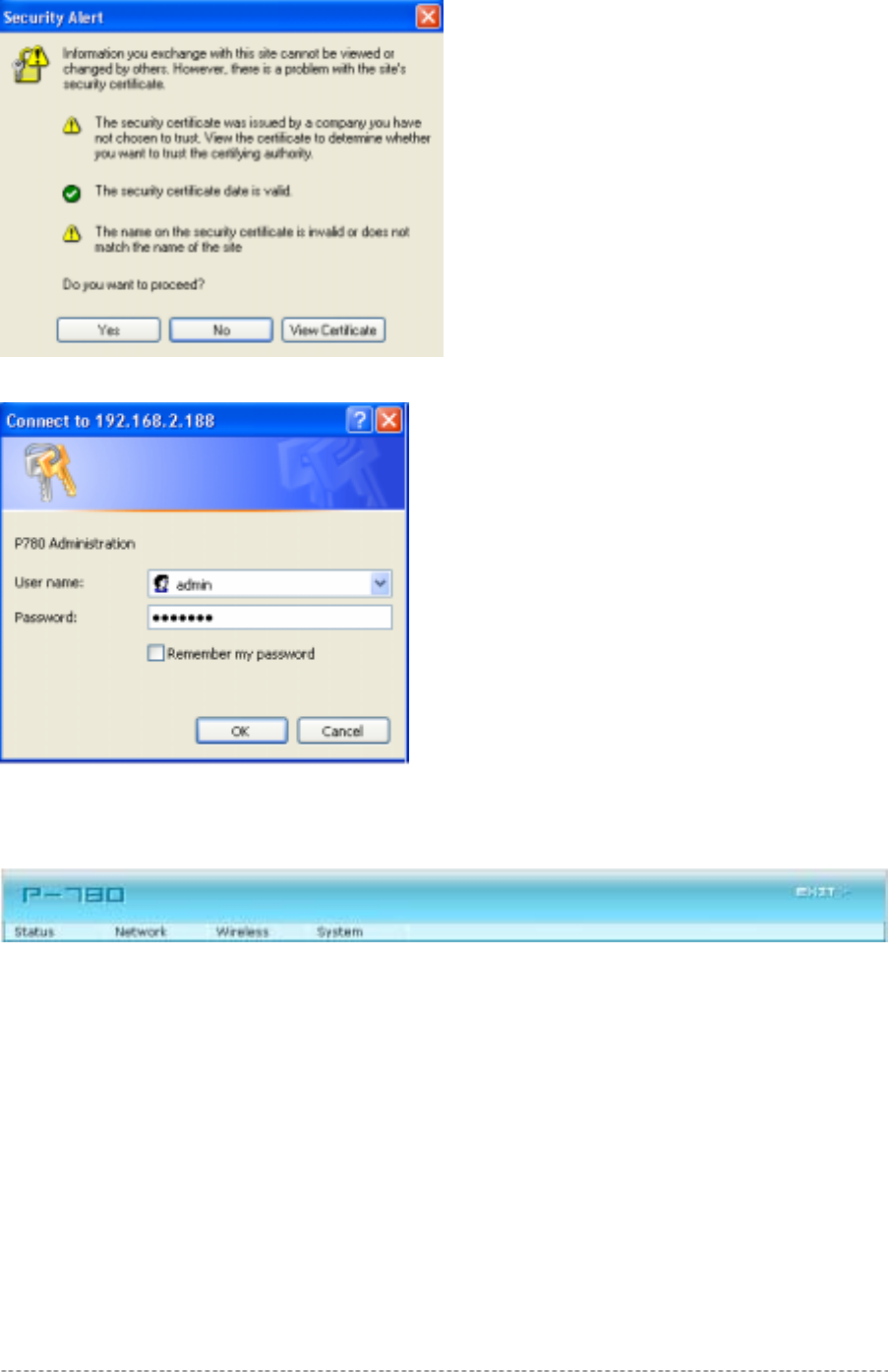
P-780 User’s Guide v1.2 February 7, 2005
Gemtek Systems Page 18 of 60
Step 3 After successful administrator log on you will see the main page of the P-780’s Web
interface:
If second method is prefered follow the instuctions:
Step 1 Install the KickStart utility from the Installation CD. Click Start > Programs >
Gemtek Systems > KickStart to launch the application. If the P-780 device is
connected to your network, the utility will automatically find your P-780:
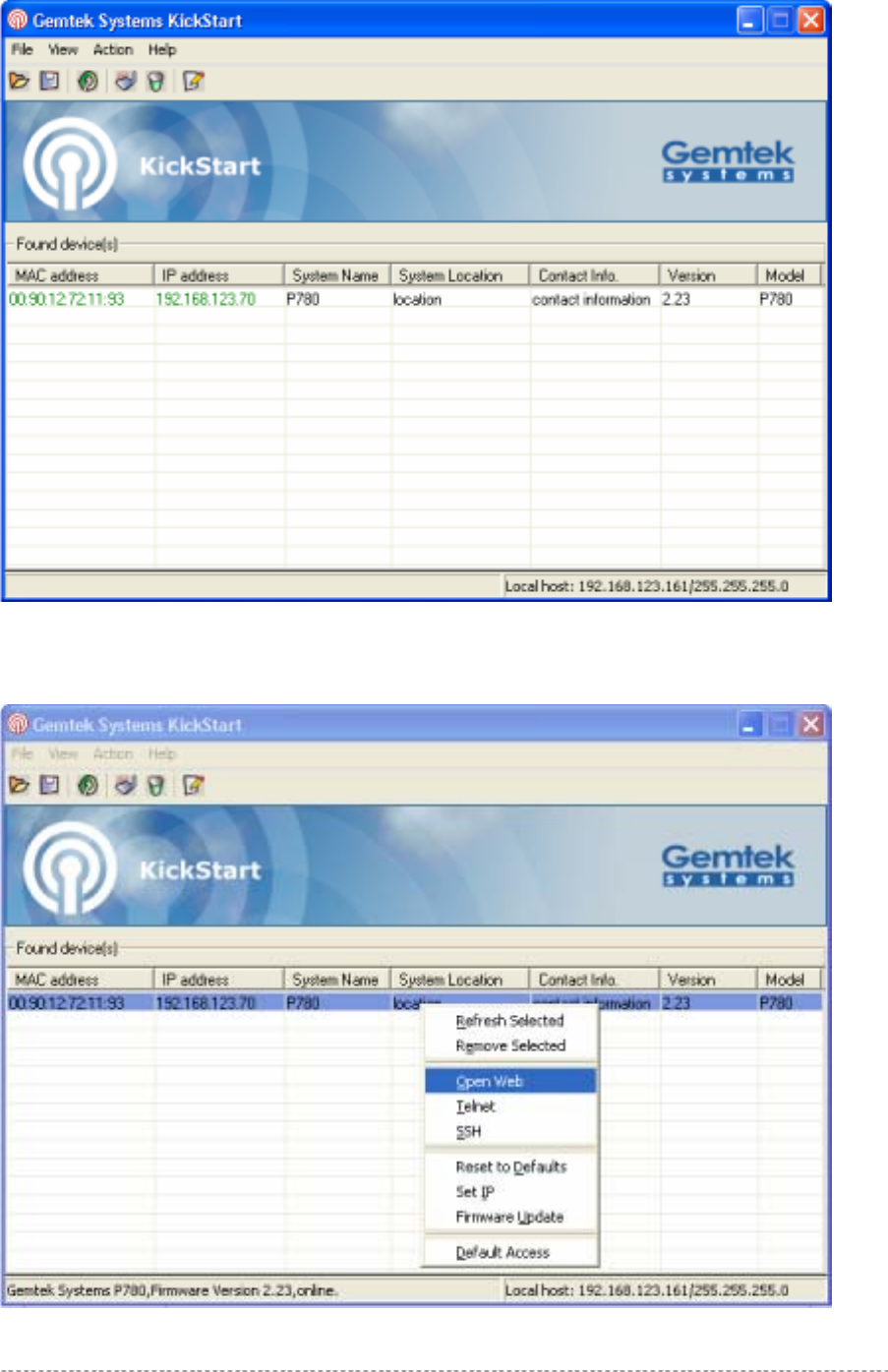
P-780 User’s Guide v1.2 February 7, 2005
Gemtek Systems Page 19 of 60
Step 2 Select your controller and right click. Select Open WEB item to launch the web
management interface through the secure https connection:

P-780 User’s Guide v1.2 February 7, 2005
Gemtek Systems Page 20 of 60
Step 3 Enter the P-780 administrator login settings to access the web management
interface.
The default administrator log on settings for all access point interfaces are:
User name: admin
Password: admin01
Step 4 After successful administrator log on you will see the controller web interface.
Now you are enabled to perform your configuration.
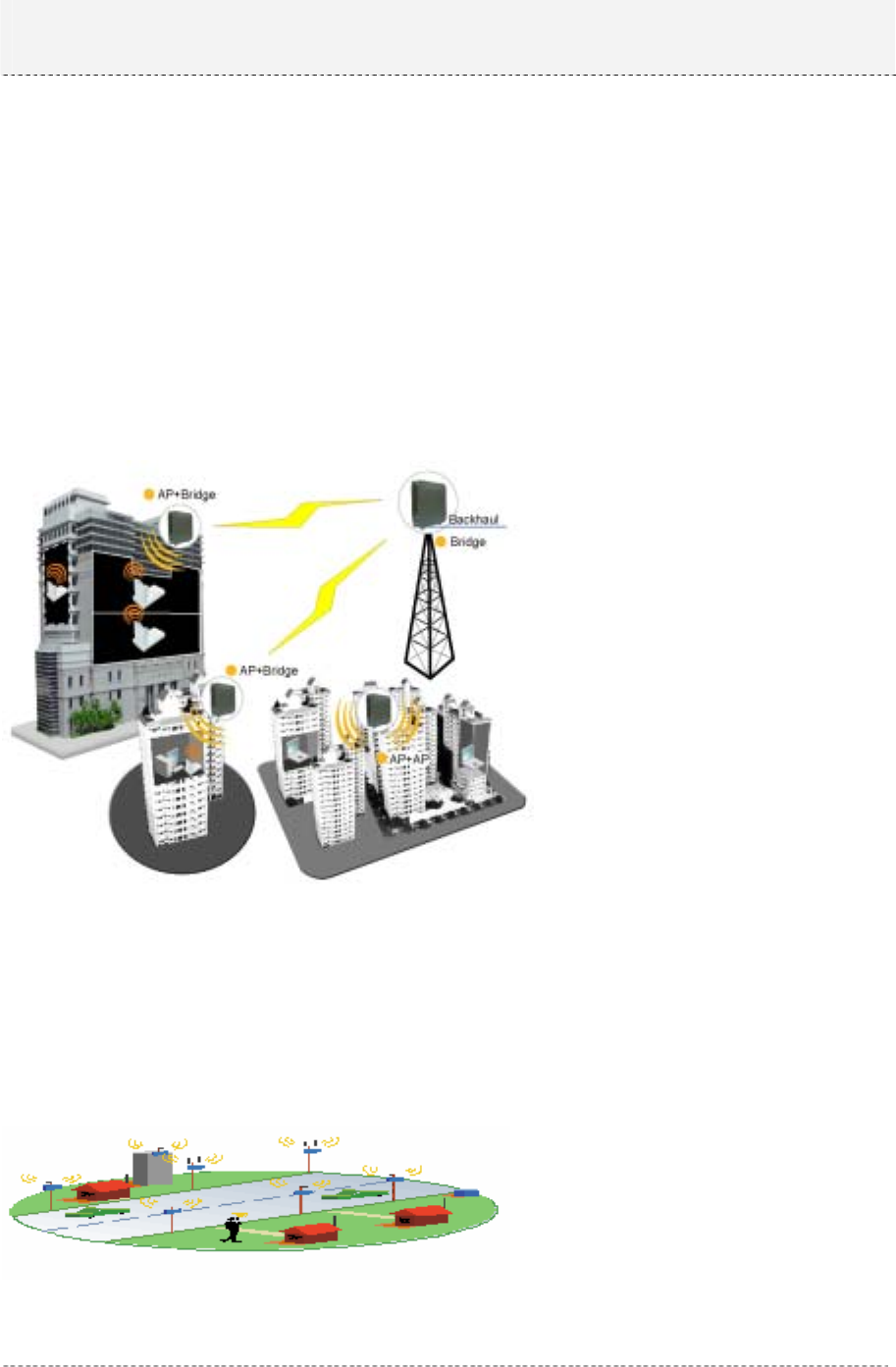
P-780 User’s Guide v1.2 February 7, 2005
Gemtek Systems Page 21 of 60
The two Dual-Band chips (a/g + a/g) that this product provides supplies the furthest flexible
application. Three application modes are supplied by P-780:
z AP + Bridge mode
z AP + AP mode
z Bridge + Bridge mode
AP + Bridge Mode
AP + Bridge configuration is for environment with last mile issue.
The typical usage is: 11g AP + 11a Bridge.
Figure 7 – AP +Bridge application mode
AP + AP Mode
AP + AP configuration can be for client density environment.
The typical usage is: 11g AP + 11a AP.
Figure 8 – AP +AP application mode
Chapter 3 – Application Mode
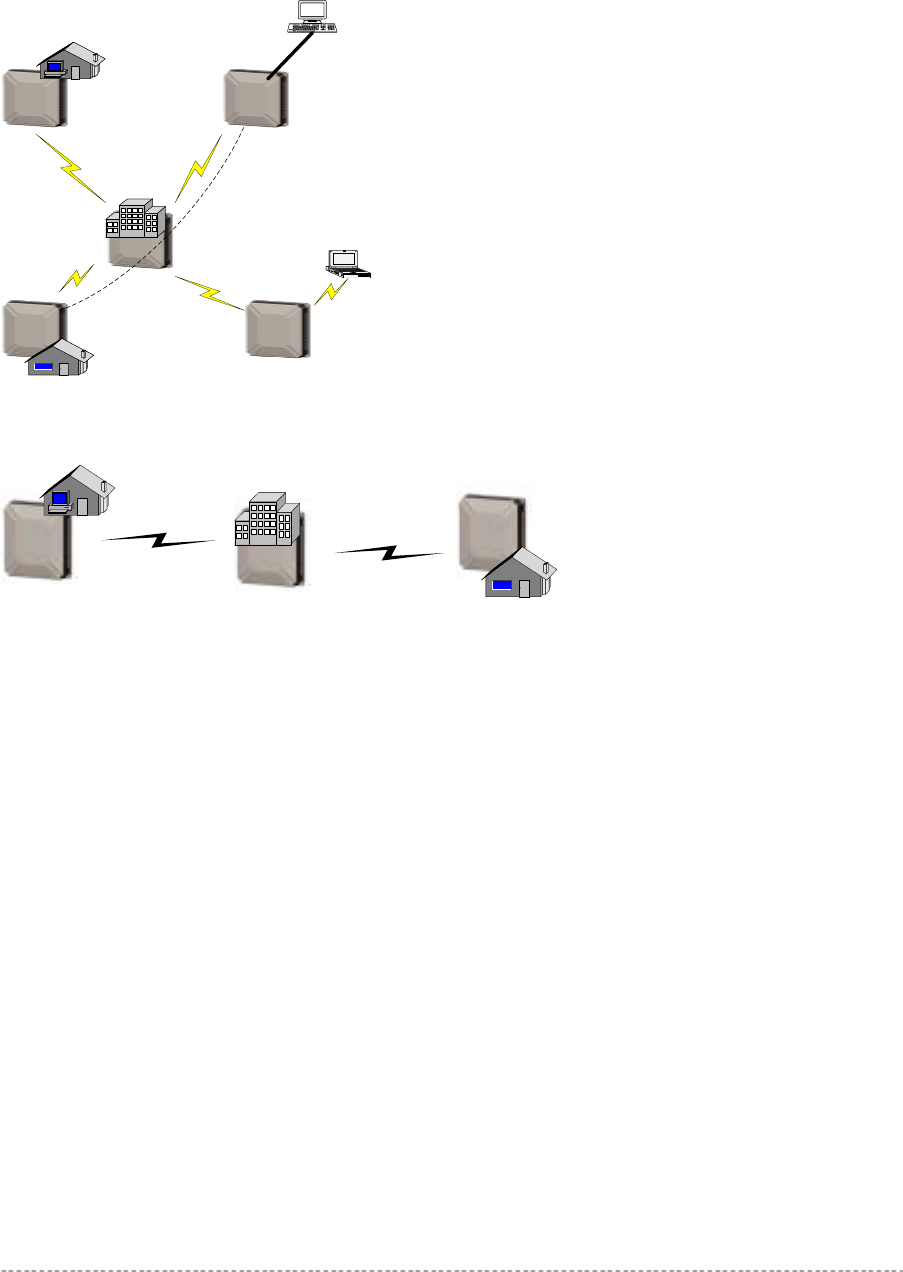
P-780 User’s Guide v1.2 February 7, 2005
Gemtek Systems Page 22 of 60
Bridge+ Bridge Mode
Bridge + Bridge mode is used in the area without Ethernet wiring.
The typical usage is: 11a Bridge + 11a Bridge for Point to Multi-Point or for wireless Repeater.
Figure 9 – Bridge +Bridge application mode in Point to Multi-Point
Figure 10– Bridge +Bridge application mode as wireless repeater
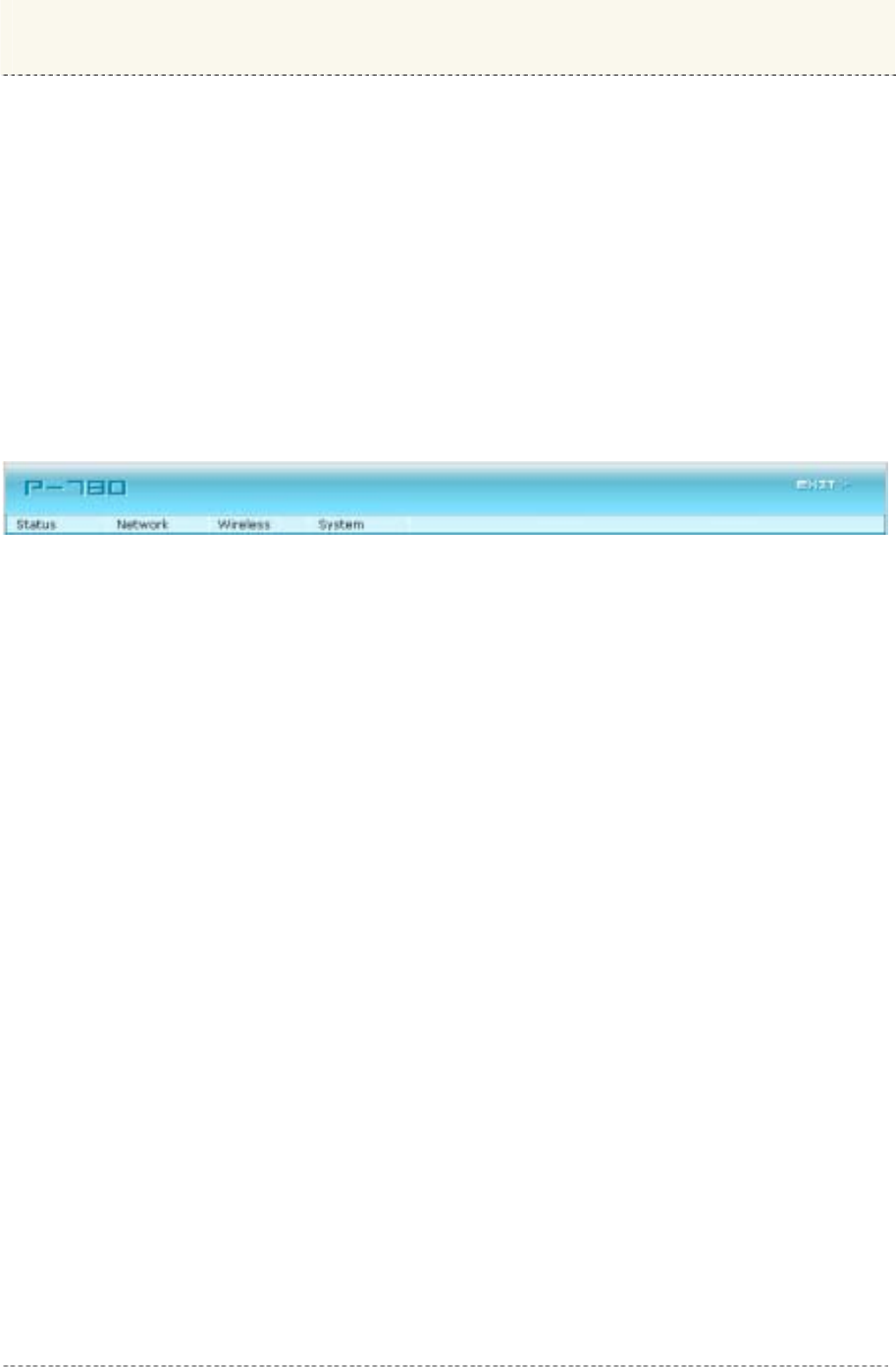
P-780 User’s Guide v1.2 February 7, 2005
Gemtek Systems Page 23 of 60
This chapter contains web management reference information.
The web management main menu consists of the following sub menus:
Status – device status showing
Network – device settings affecting networking
Wireless – device settings related to the wireless part of the P-780
System – device system settings directly applicable to the P-780
Exit – click exit and leave the web management then close your web-browser window.
Web Interface
The main web management menu is displayed at the top of the page after successfully logging into
the system (see the figure below). From this menu all essential configuration pages are accessed.
Figure 11 – Main Configuration Management Menu
The web management menu has the following structure:
Status
Device Status – show the status related with the whole device
Wireless Status – show the status of the two radios
Network
Interface – TCP/IP settings of P-780 LAN (Bridge) port
RADIUS Server – specify the settings of RADIUS server which is used by 802.1x or WPA
DHCP Settings– specify the settings of DHCP server or DHCP relay service
Wireless
Basic – specify the basic settings related with wireless part
Advance – specify the settings of multiple BSSID or Bridge
WEP – specify the WEP settings related with static WEP encryption
MAC ACL – MAC ACL settings for P-780
System
Security – set access permission to your P-780
SNMP – SNMP service
Telnet – Telnet/SSH service
Configuration – system configuration utilities, including Backup/Upload configuration
Reset – reboot device and restore systems to factory default
Upgrade – Upgrade the firmware remotely
In the following sections, short references for all menu items are presented.
Chapter 4 – Reference Manual
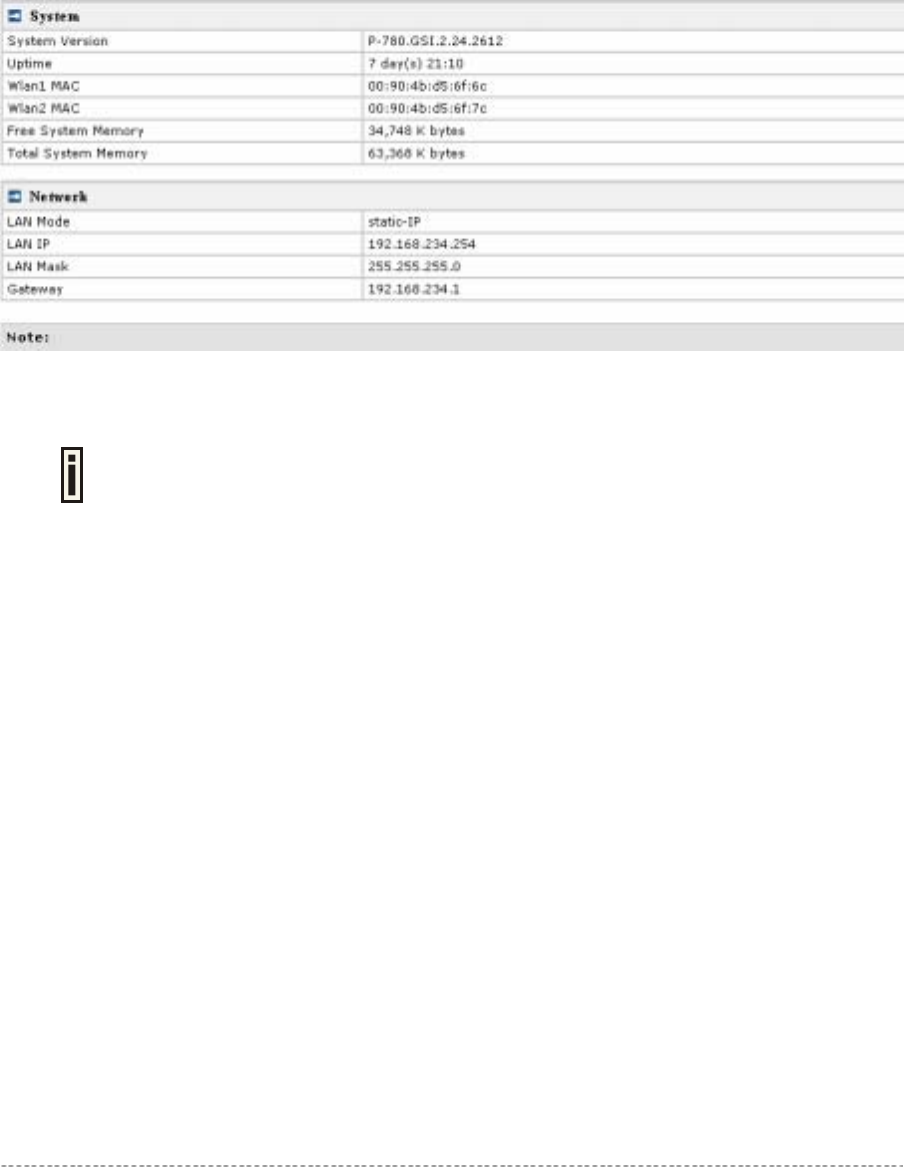
P-780 User’s Guide v1.2 February 7, 2005
Gemtek Systems Page 24 of 60
Status
Status | Device Status
The device status page shows important information for the P-780, its system status and network
configuration.
Figure 12 – Device Status
System Version display the current version of the firmware loaded to the AP
This is important information for support requests and for preparing firmware
upgrading
Uptime indicates the time, expressed in days, hours and minutes since the system was last rebooted.
Wlan1 MAC / Wlan 2 MAC shows the MAC addresses of the two wireless interfaces of the P-780
Free System Memory indicates the memory currently available in the P-780
Total System Memory indicates the total memory in the P-780
LAN Mode indicate static IP or DHCP client is used for P-780 LAN IP address
LAN IP shows the LAN IP address of P-780
LAN Mask shows the LAN Network Mask of P-780
Gateway shows the default gateway of P-780
Status | Wireless Status
The wireless status shows the information related with P-780 two wireless interfaces.
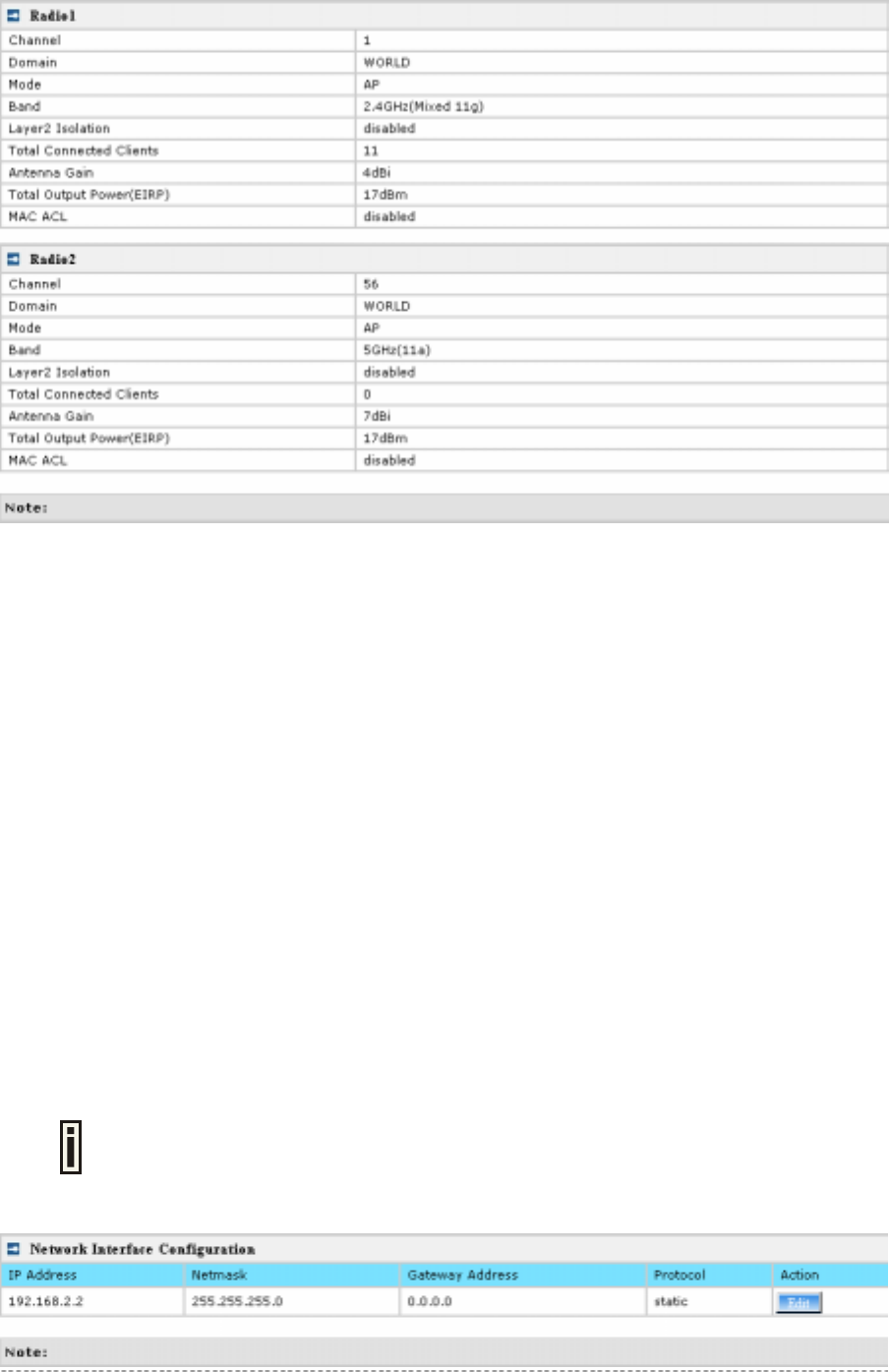
P-780 User’s Guide v1.2 February 7, 2005
Gemtek Systems Page 25 of 60
Figure 13 – Wireless Status
Radio1 / Radio2 relates with two wireless interfaces
Channel indicates which channel is in use.
Domain indicates regulatory domain set on the P-780
Mode AP or Bridge mode is be used for this wireless interface
Band specify which band is in use for wireless interface
Layer2 Isolation specify the status of Layer2 Isolation service on this wireless interface
Total Connected Clients indicates number of the currently connected clients to your P-780
Antenna Gain indicates antenna Gain value. If use A-807, which is approved/attached Antenna of P-
780, Antenna Gain shows 4dBi in 2.4GHz and 7dBi in 5GHz for regulation’s limitation. If use other
external antenna, this will shows 0dBi.
Total Output Power (EIRP) indicates EIRP value set to the P-780
MAC ACL indicates the status of MAC ACL feature on P-780
Network
Network | Interface
The interface configured is bridge device therefore only one interface is displayed
here for configuration.
Bridge interface and its settings are listed in the Interface page.
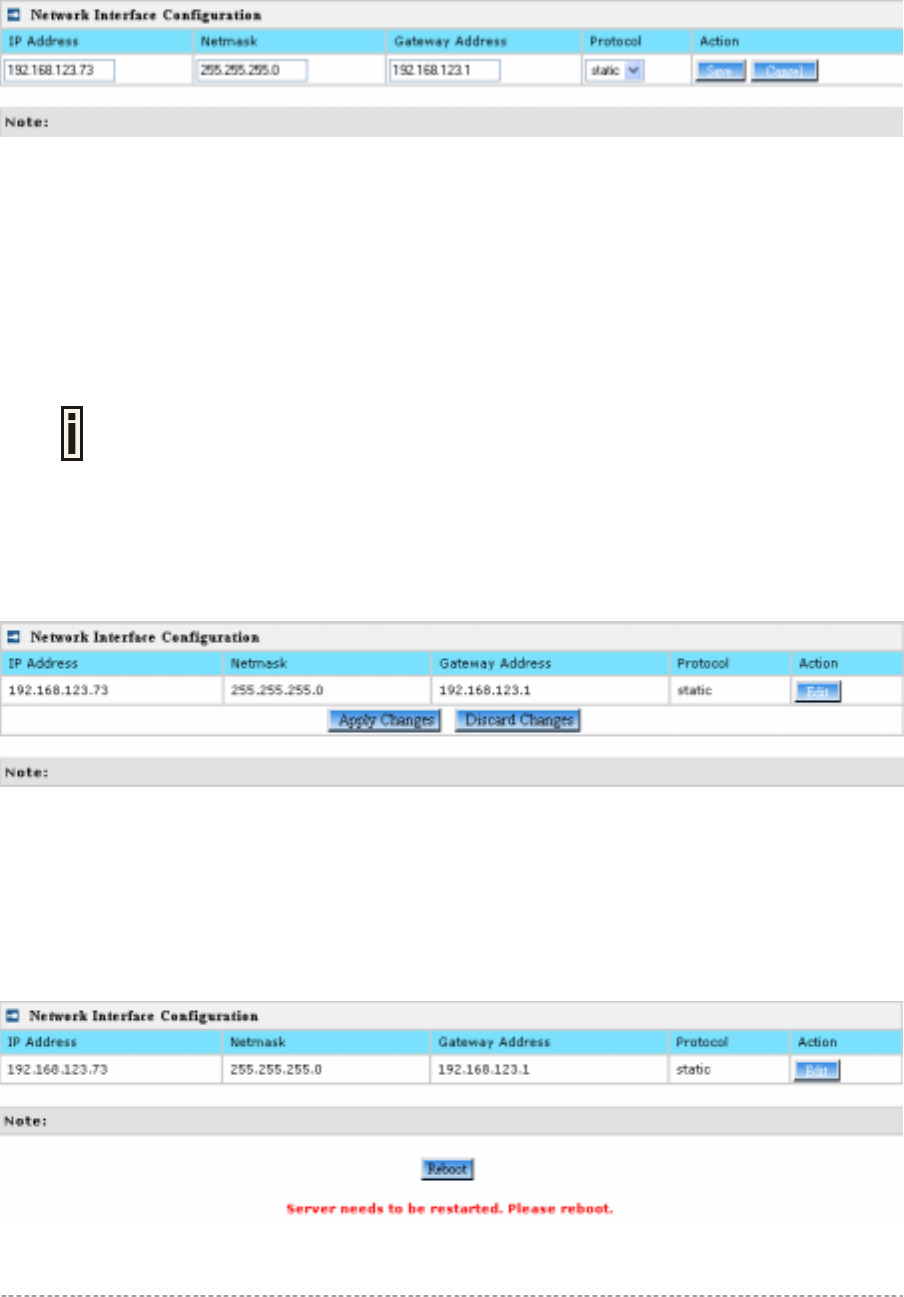
P-780 User’s Guide v1.2 February 7, 2005
Gemtek Systems Page 26 of 60
Figure 14 – Interface Configuration Table
To change network interface (bridge) configuration properties click the Edit button in the Action
column. The status can be changed now:
Figure 15 – Edit Interface Configuration Settings
IP Address - specify new interface IP address [in digits and dots notation, e.g. 192.168.123.70].
Netmask – specify the subnet mask [[0-255].[0-255].[0-255].[0-255]].These numbers are a binary
mask of the IP address, which defines IP address order and the number of IP addresses in the subnet.
Gateway Address – interface gateway. For Bridge type interfaces, the gateway is always the
gateway router.
Protocol – specify static for setting IP address manually and dhcp for getting IP address dynamically
acting as DHCP client.
When dhcp is used for getting IP address, Kickstart is recommended to find your
device.
Save – save the entered values.
Cancel – restore all previous values.
Change status or leave in the default state if no editing is necessary and click the Save button.
Figure 16 – Apply or Discard Interface Configuration Changes
Apply Changes – to save all changes in the interface table at once.
Discard Changes – restore all previous values.
For such each change of settings, the P-780 needs to be restarted to apply all settings changes when
clicking Apply Changes. Request for reboot server appears:
Figure 17 – Reboot Server
Reboot – Click the button to restart the server and apply the changes.
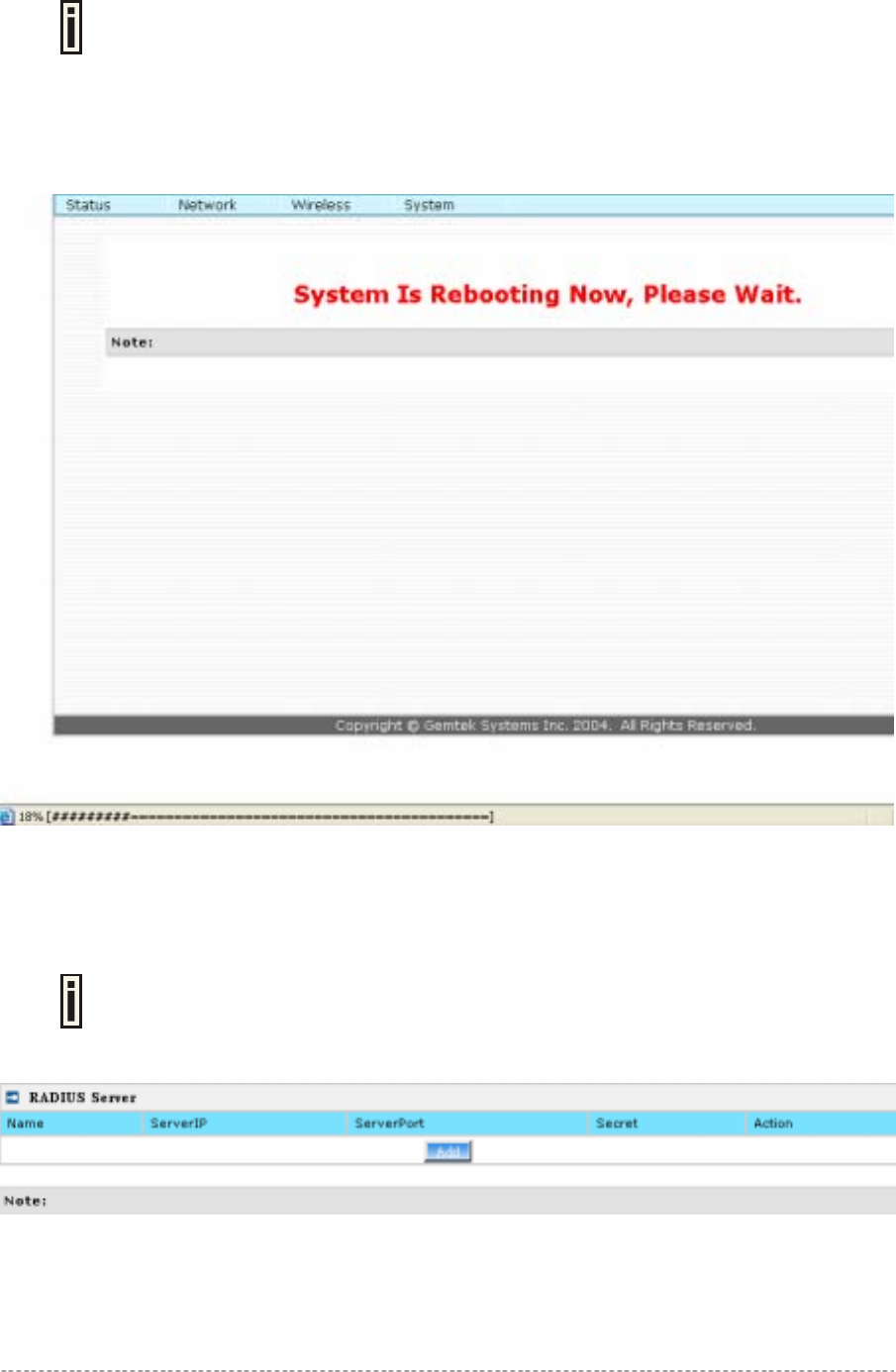
P-780 User’s Guide v1.2 February 7, 2005
Gemtek Systems Page 27 of 60
If there is no other setting needed to be modified, click the Reboot button for
applying all modifications.
And if there are still other setting modifications needed, go ahead to finish all
changes and then click Reboot button to restart and apply all settings together.
To reboot at once, click Reboot button and then it is necessary to wait a moment. And the message
of reboot appears just like bellows:
Figure 18 – Reboot Information
Network | RADIUS Server
Up to 32 different RADIUS servers can be configured under the RADIUS servers
menu.
By default, one RADIUS server is specified for the system:
Figure 19 – RADIUS Servers Settings
Add – add new RADIUS server.
Click Add to configure RADIUS server settings.
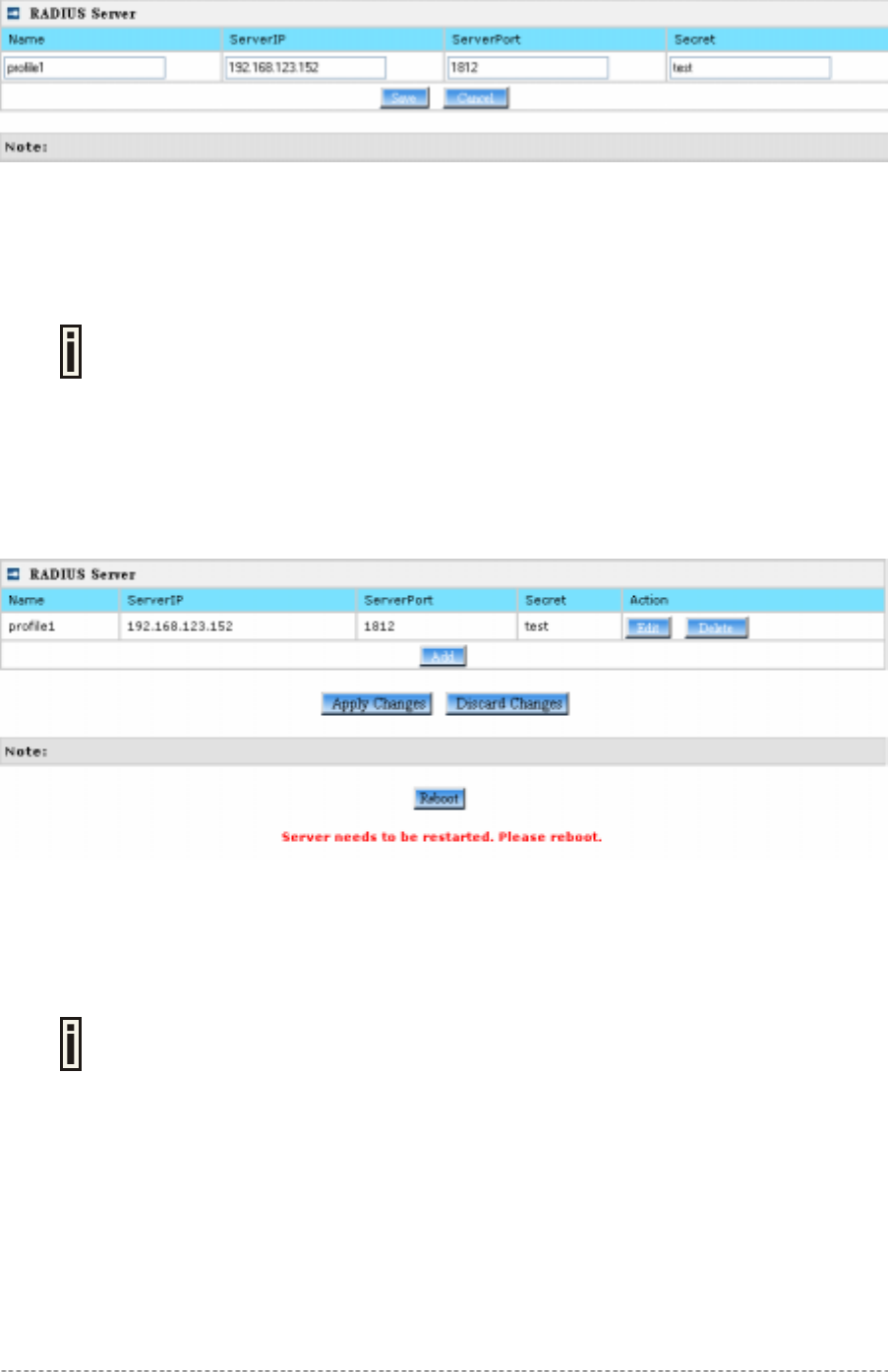
P-780 User’s Guide v1.2 February 7, 2005
Gemtek Systems Page 28 of 60
Figure 20 – RADIUS Server's Details
Name – specify the new RADIUS server name which is used for selecting RADIUS server.
Server IP – authentication RADIUS server IP address [dots and digits].
Server Port – specify the network port used to communicate with RADIUS [1-65535].
The port default value of 1812 is based on RFC 2138 "Remote Authentication Dial-
in User Service (RADIUS)".
Secret – shared secret string that is used to make sure the integrity of data frames used for
authentication server.
Save – add new specified RADIUS server.
Cancel – restore all previous values.
After adding a new RADIUS server or editing an existing one, the following control appears:
Edit – edit an existing RADIUS server settings
Delete – delete an existing RADIUS server settings
Reboot – restart the controller to make applied changes work.
If there is no other setting needed to be modified, click the Reboot button for
applying all modifications.
And if there are still other setting modifications needed, go ahead to finish all
changes and then click Reboot button to restart and apply all settings together.
Network | DHCP Settings
P-780 can act as DHCP server or DHCP relay. The DHCP (Dynamic Host Configuration Protocol)
service is supported on physical interfaces.
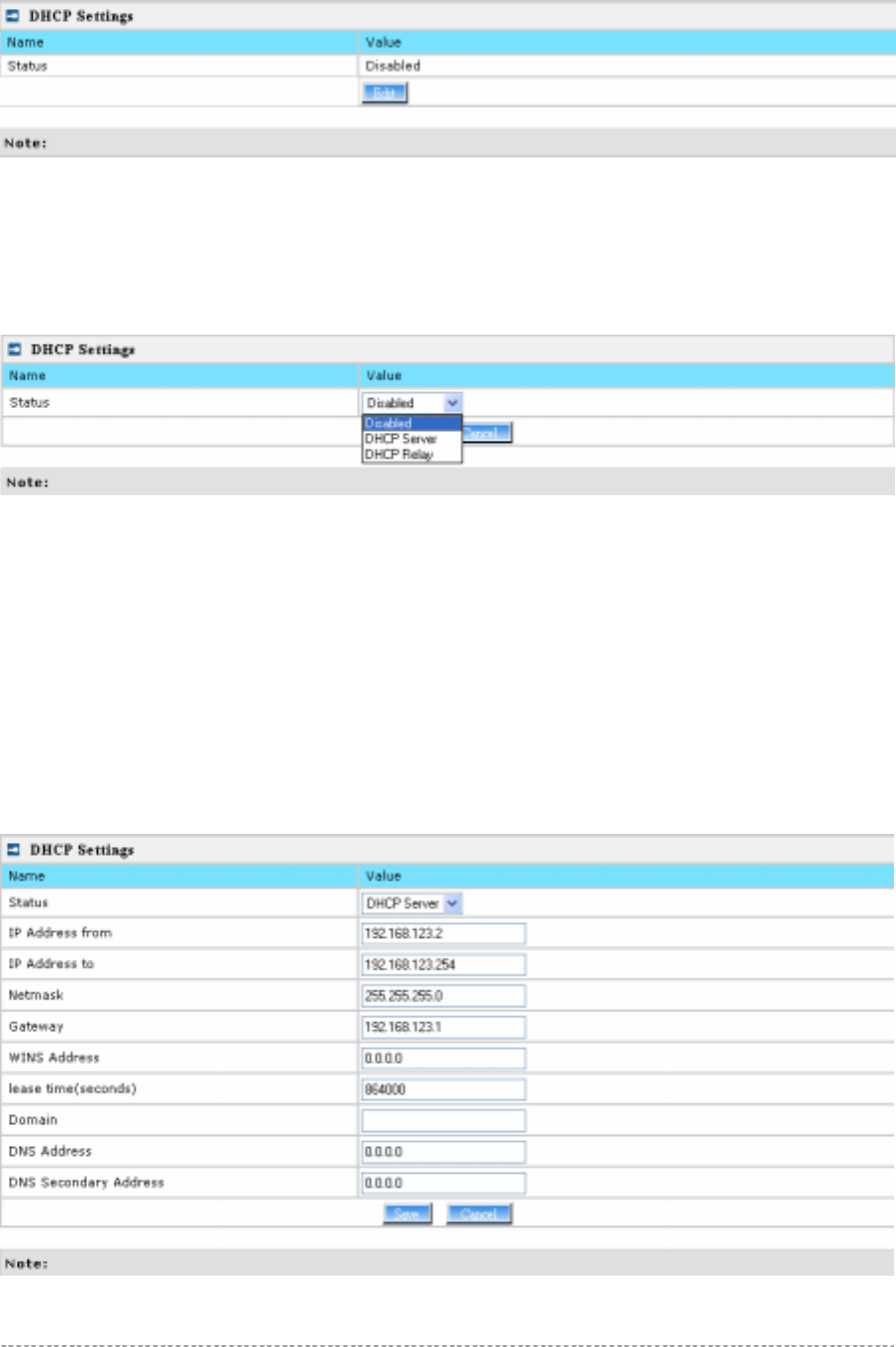
P-780 User’s Guide v1.2 February 7, 2005
Gemtek Systems Page 29 of 60
DHCP server and DHCP relay is disabled by default.
Figure 21 –DHCP Settings
Edit – edit the wireless basic settings
To change DHCP setting properties click the Edit button, the DHCP server or DHCP relay service
should be configured:
Figure 22 –DHCP Settings
Status – Select status from the drop-down menu.
Disabled – Disable the DHCP server service.
DHCP Server – Enable the DHCP server service.
DHCP Relay – Enable the DHCP Relay service.
Choose DHCP Server to enable DHCP server service. Choose DHCP Relay to enable DHCP relay
service.
DHCP Server
This DHCP server service enables clients on the LAN to request configuration information, such as IP
address, from a server. Settings of the DHCP service can be viewed just like the follow page.
Figure 23 –DHCP server Settings
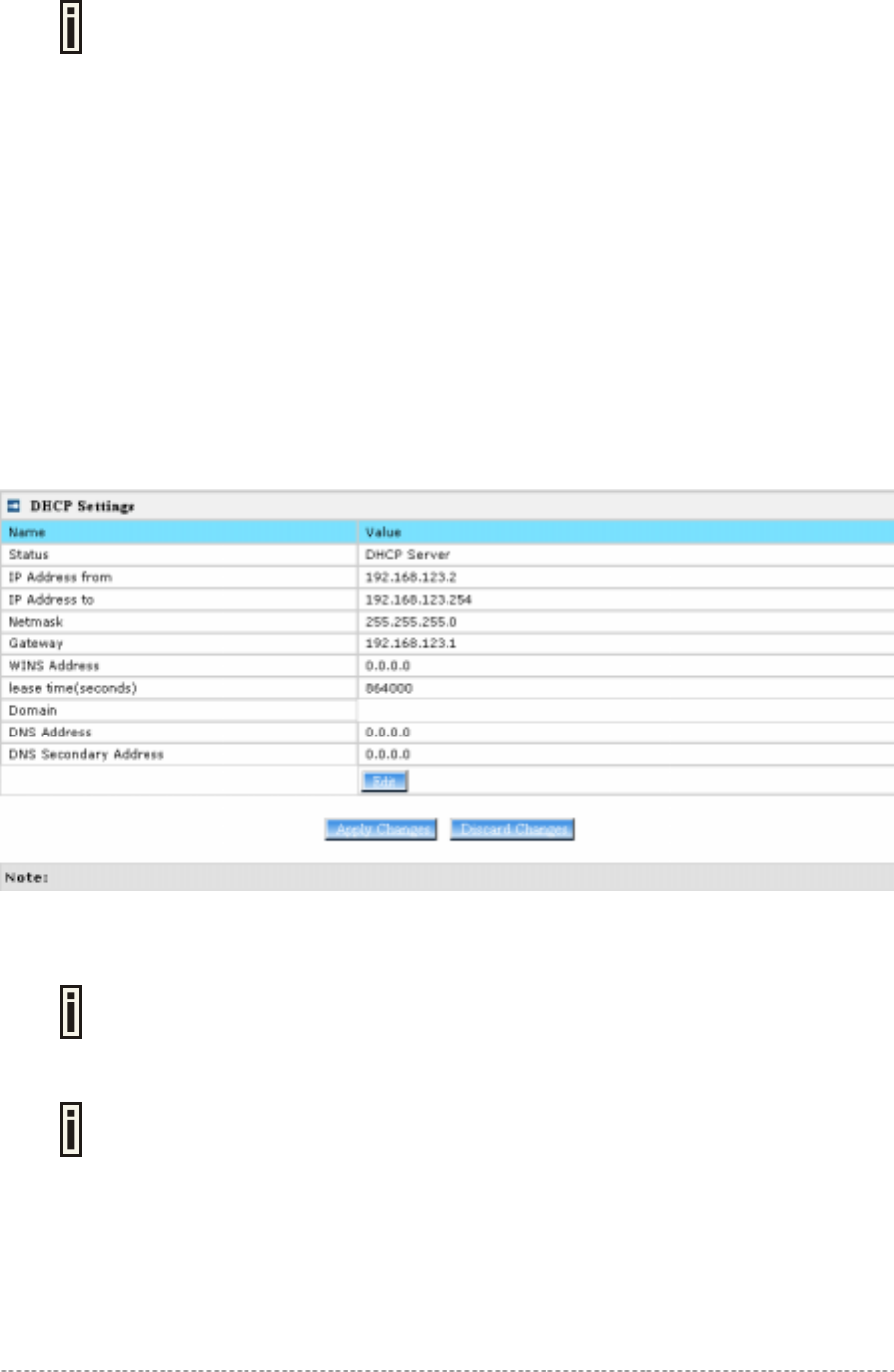
P-780 User’s Guide v1.2 February 7, 2005
Gemtek Systems Page 30 of 60
By default, DHCP server is disabled for P-780.
IP Address from / IP Address to – specify the IP address range to be dynamically allocated by the
DHCP server.
Netmask – enter the netmask for IP pool range.
Gateway – enter the gateway IP for wireless clients.
WINS Address (Windows Internet Naming Service) – specify server IP address if it is available on the
network [dots and digits].
Lease Time – specify the IP address lease interval in seconds [1-1000000].
Domain – specify the DHCP domain name [optional, 1-128 sting].
DNS address – specify the DNS server’s IP address [in digits and dots notation].
DNS secondary address – specify the secondary DNS server’s IP address [in digits and dots
notation].
Change status or leave in the default state if no editing is necessary and click the Save button.
Figure 24 –Apply or Discard DHCP server Settings
The DHCP server settings will be automatically adjusted to match the network
interface settings.
The Gateway of DHCP server settings must be same with the Gateway of P-780
For each change of settings, the P-780 needs to be restarted to apply all settings changes when
clicking Apply Changes. Request for reboot server appears:
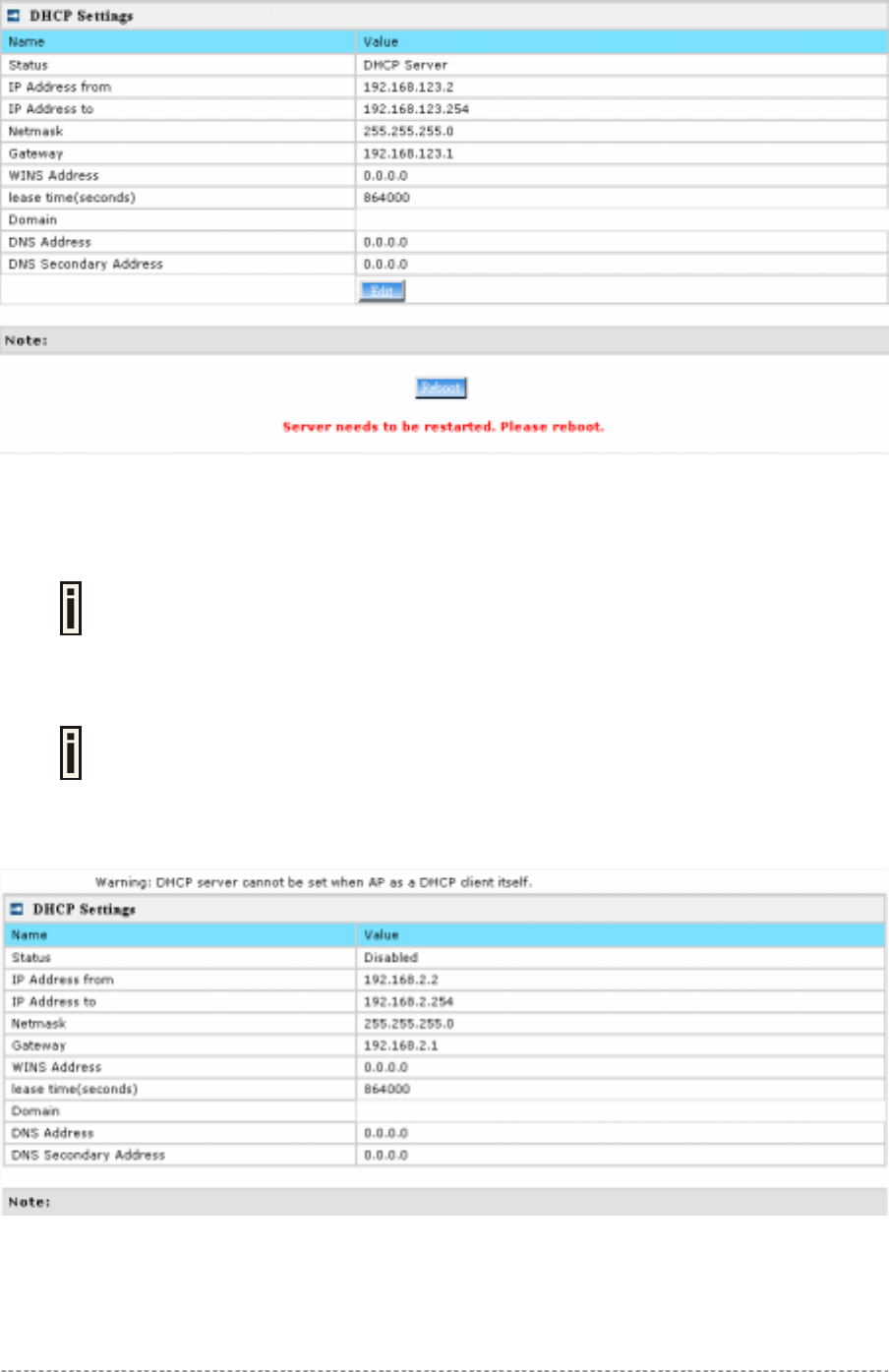
P-780 User’s Guide v1.2 February 7, 2005
Gemtek Systems Page 31 of 60
Figure 25 – Reboot information
Reboot – Click the button to restart the server and apply the changes.
If there is no other setting needed to be modified, click the Reboot button for
applying all modifications.
And if there are still other setting modifications needed, go ahead to finish all
changes and then click Reboot button to restart and apply all settings together.
When P-780 network Interface uses DHCP to get IP address dynamically, DHCP
server service cannot be enabled.
When P-780 uses DHCP to get IP address, the similar WEB UI will be appears:
Figure 26 – Warning information
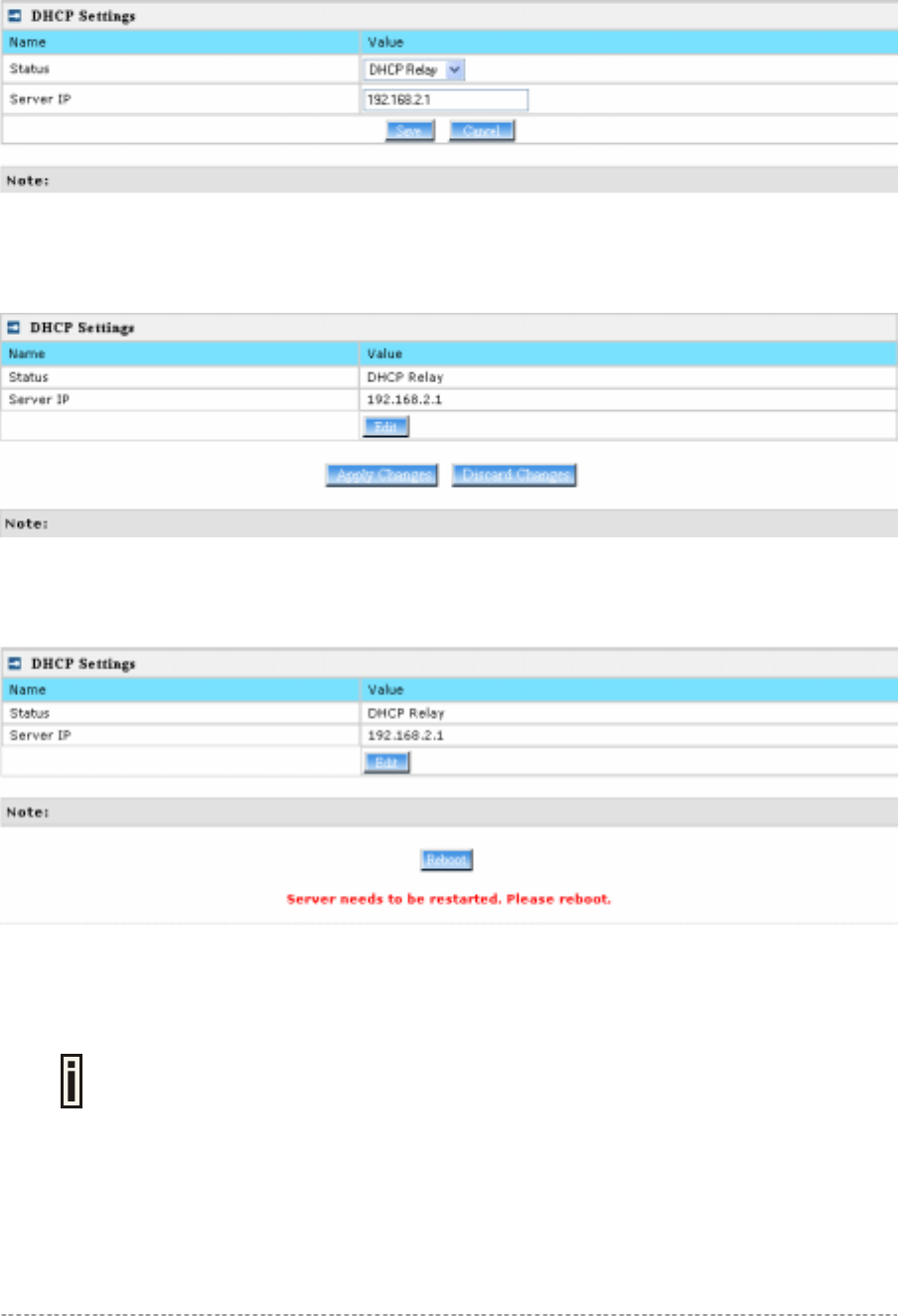
P-780 User’s Guide v1.2 February 7, 2005
Gemtek Systems Page 32 of 60
DHCP Relay
To route DHCP through the external server, enable the DHCP Relay service.
Figure 27 – DHCP Relay settings
Server IP: enter the IP address of the external DHCP server.
Change status or leave in the default state if no editing is necessary and click the Save button.
Figure 28 –Apply or Discard DHCP relay Settings
For each change of settings, the P-780 needs to be restarted to apply all settings changes when
clicking Apply Changes. Request for reboot server appears:
Figure 29 – Reboot information
Reboot – Click the button to restart the server and apply the changes.
If there is no other setting needed to be modified, click the Reboot button for
applying all modifications.
And if there are still other setting modifications needed, go ahead to finish all
changes and then click Reboot button to restart and apply all settings together.
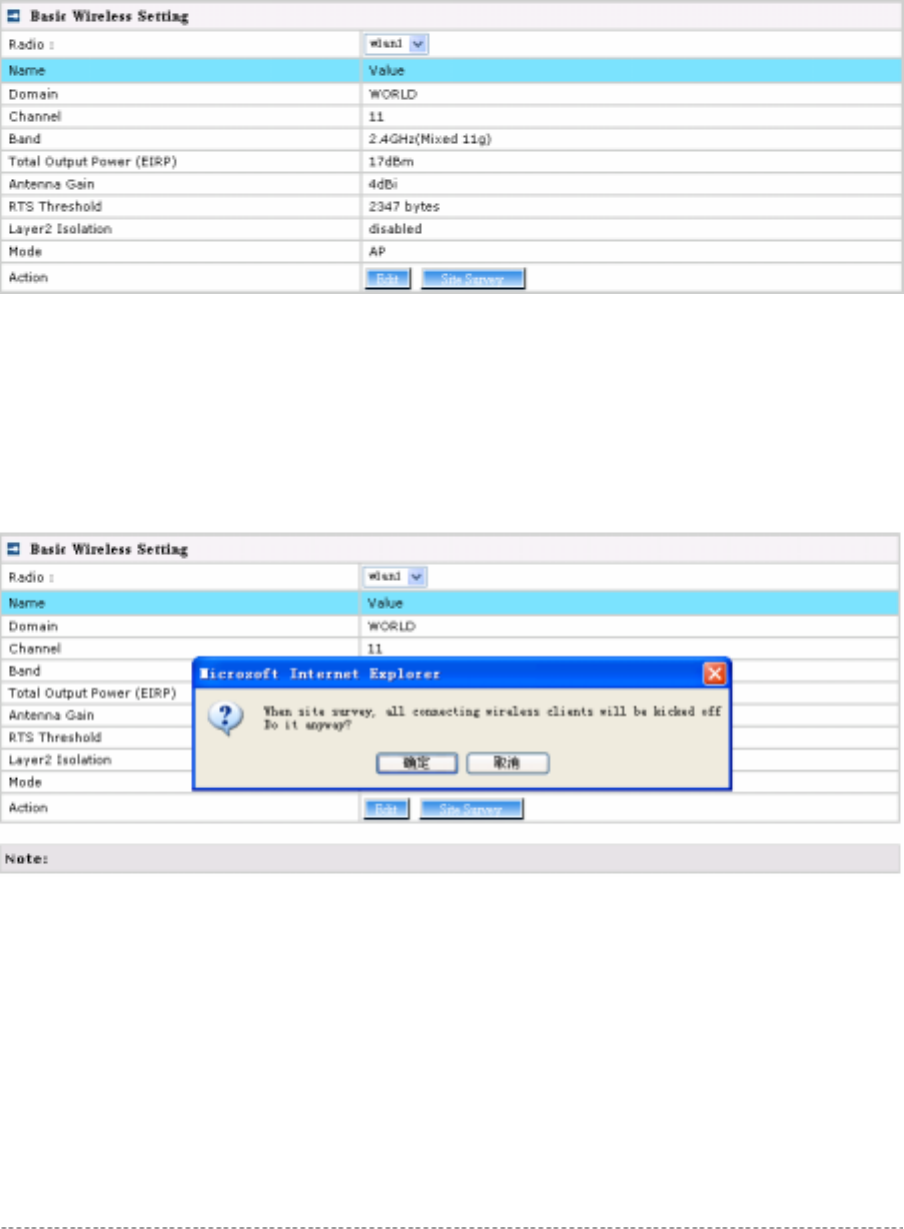
P-780 User’s Guide v1.2 February 7, 2005
Gemtek Systems Page 33 of 60
Wireless
Wireless | Basic
Use the wireless | Basic menu to configure such wireless settings as regulatory domain, channel,
band, and power, layer2isolation. Click the edit button on the setting you need to change:
Figure 30 – Basic Wireless Settings
Site Survey –perform survey to show overview information for wireless networks in a local geography
The site survey shows overview information for wireless networks in a local geographic area. Using
this survey, administrator can scan for working access points, check their operating channels, and see
RSSI levels. To start the scan, simply click the Site Survey menu.
After clicking Site Survey, you will get the follow warning:
Figure 31 – Site Survey warning
Click OK to continue site survey and get the similar UI:
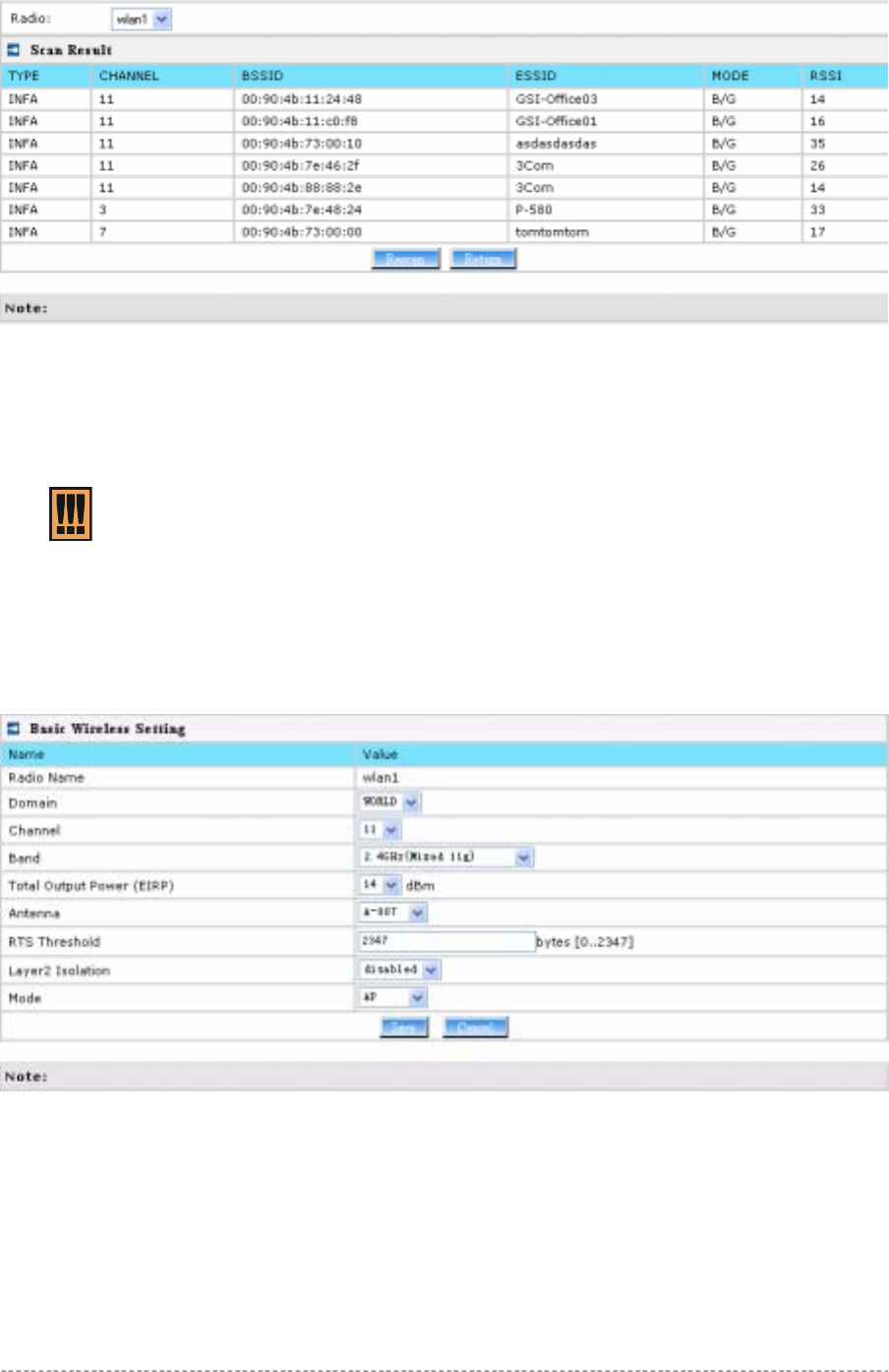
P-780 User’s Guide v1.2 February 7, 2005
Gemtek Systems Page 34 of 60
Figure 32 – Site Survey information
To refresh the statistics click the Rescan button.
During Site Survey, all wireless clients which are connecting with P-780 would be
kicked off.
Site Survey takes some minutes to perform. Please wait and don’t power off AP
during site survey.
Edit – edit the wireless basic settings
To change basic wireless setting properties click the Edit button in the Action column. The status
can be changed now:
Figure 33 – Edit Basic Wireless Settings
Change status or leave in the default state if no editing is necessary and click the Save button.
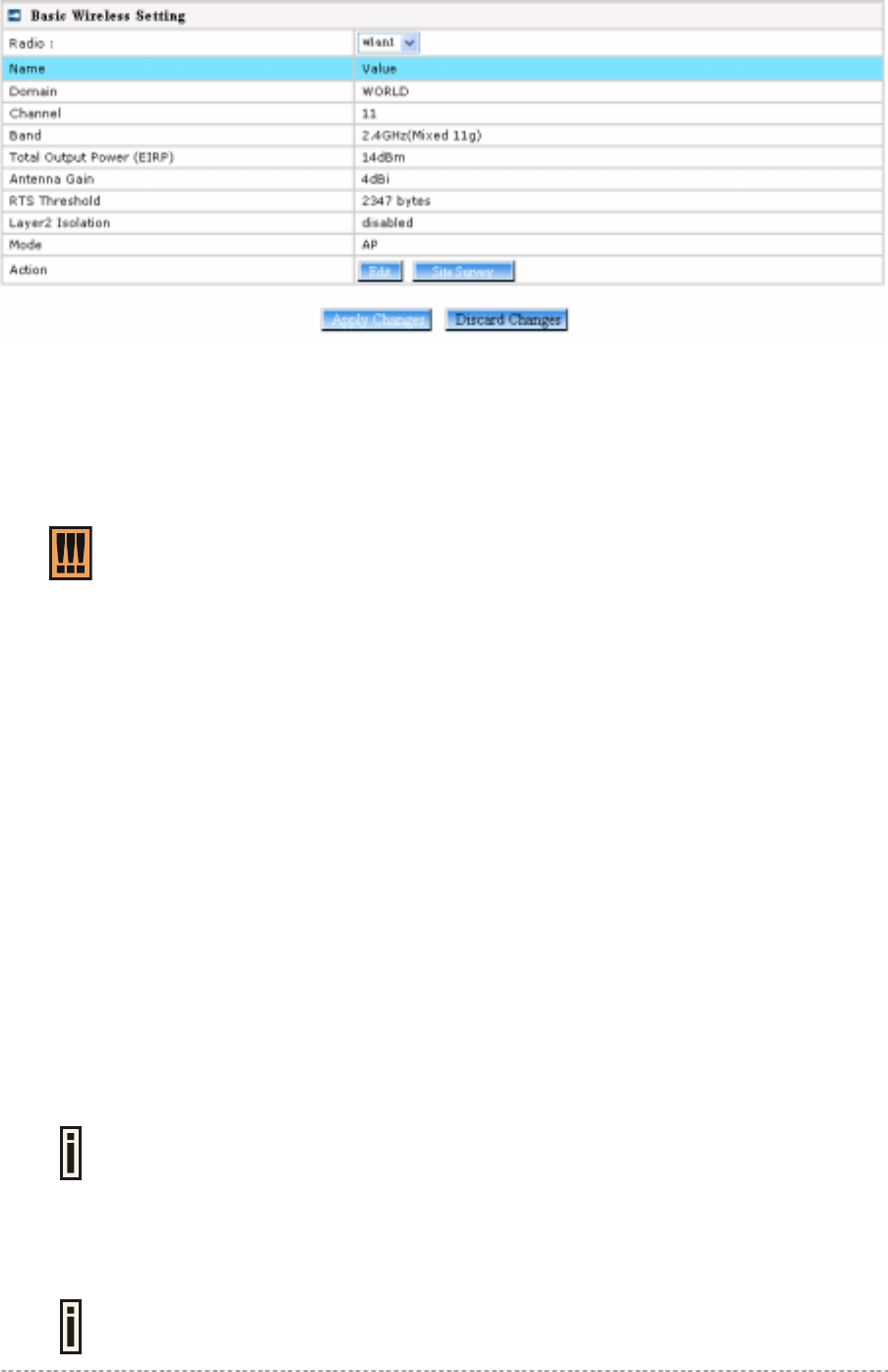
P-780 User’s Guide v1.2 February 7, 2005
Gemtek Systems Page 35 of 60
Figure 34 – Apply or Discard Basic Wireless Settings
Radio – specify which wireless interface of P-780 is shown
Domain – select the regulatory domain according to your country
The full frequency range of the 2.4 GHz or 5 GHz is not permitted for use in all countries. Depending
on your selection of regulatory domains, the available frequency channels will vary.
Before changing radio settings manually verify that your settings comply with
government regulations. At all times, it will be the responsibility of the end-user to
ensure that the installation complies with local radio regulations. Refer to the
Appendix:
C) Regulatory Domain/Channels.
Channels – select the channel that the access point will use to transmit and receive information. If
one channel is defined, it acts as default channel. Channels list will vary depending on selected
regulatory domain and selected band. Multiple frequency channels are used to avoid interference
between two radios of this AP, and between nearby access points. If you wish to operate more than
one access point in overlapping coverage areas, we recommend a distance of at least four channels
between the chosen channels. For example, for three Access Points in close proximity choose
channels 1, 6 and 11 for 11b/g or channels 36, 40 and 64 for 11a.
Band – working bands on which your radios are working.
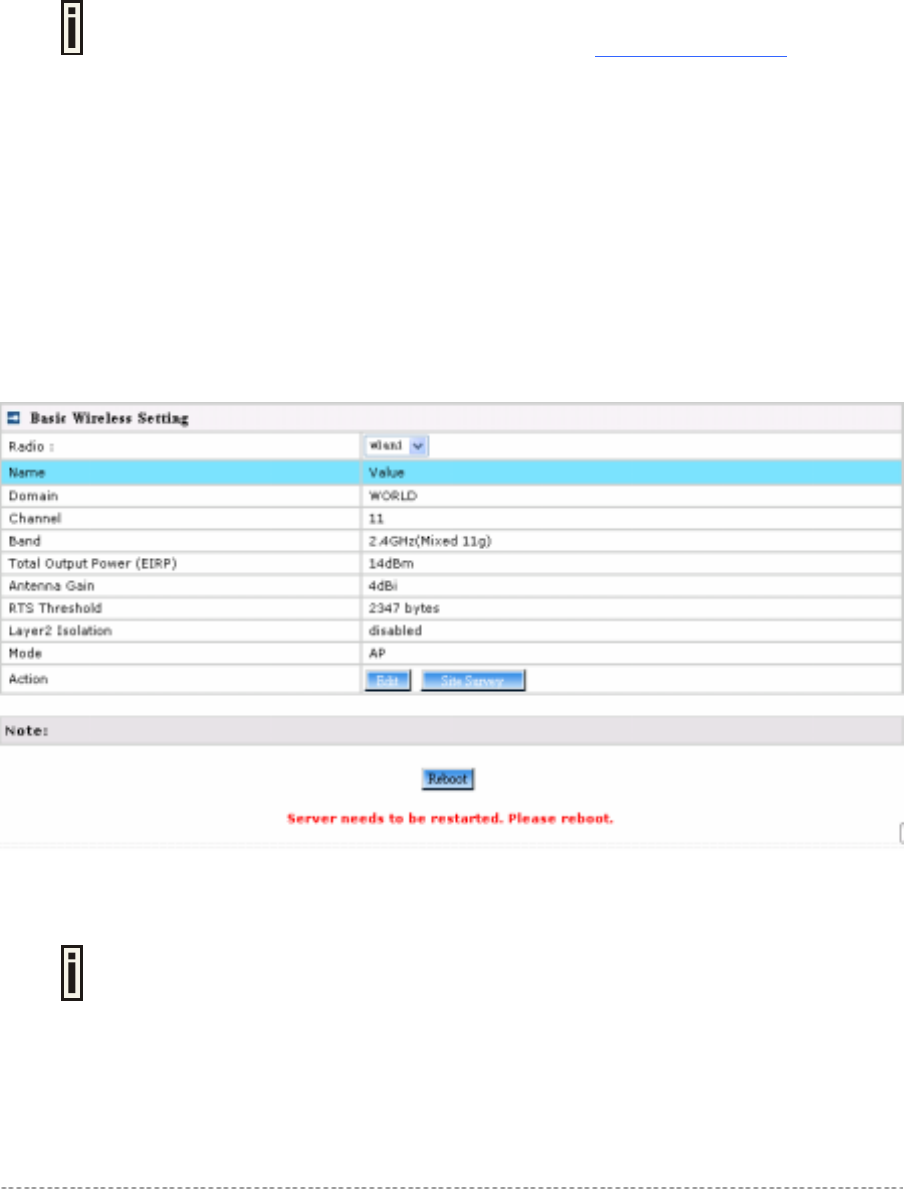
P-780 User’s Guide v1.2 February 7, 2005
Gemtek Systems Page 36 of 60
Antenna Gain: When using the approved antenna supplied by Gemtek System, you must select the
Antenna A-807 in Antenna item to meet the regulation’s power limitation. A-807 is 4.5dBi in 2.4GHz,
5dBi in 5GHz.
A-807 antenna is the accessory of P-780 Product.
RTS Threshold – when set, this settings specifies the maximum packet size beyond which RTS/CTS
mechanism is be invokes. The value range of this is [0 …2347]. Default is 2346 which means that
RTS is disabled.
Layer 2 Isolation – Layer2 wireless client separation. Connected clients with user isolation function
enabled cannot access each other directly. The clients are isolated from each other using their MAC
addresses [enabled/disabled].
Mode – two modes are supplied: AP mode and Bridge mode.
For such each change of settings, the P-780 needs to be restarted to apply all settings changes when
clicking Apply Changes. Request for reboot server appears:
Figure 35 – Reboot Server
Reboot – Click the button to restart the server and apply the changes.
If there is no other setting needed to be modified, click the Reboot button for
applying all modifications.
And if there are still other setting modifications needed, go ahead to finish all
changes and then click Reboot button to restart and apply all settings together.
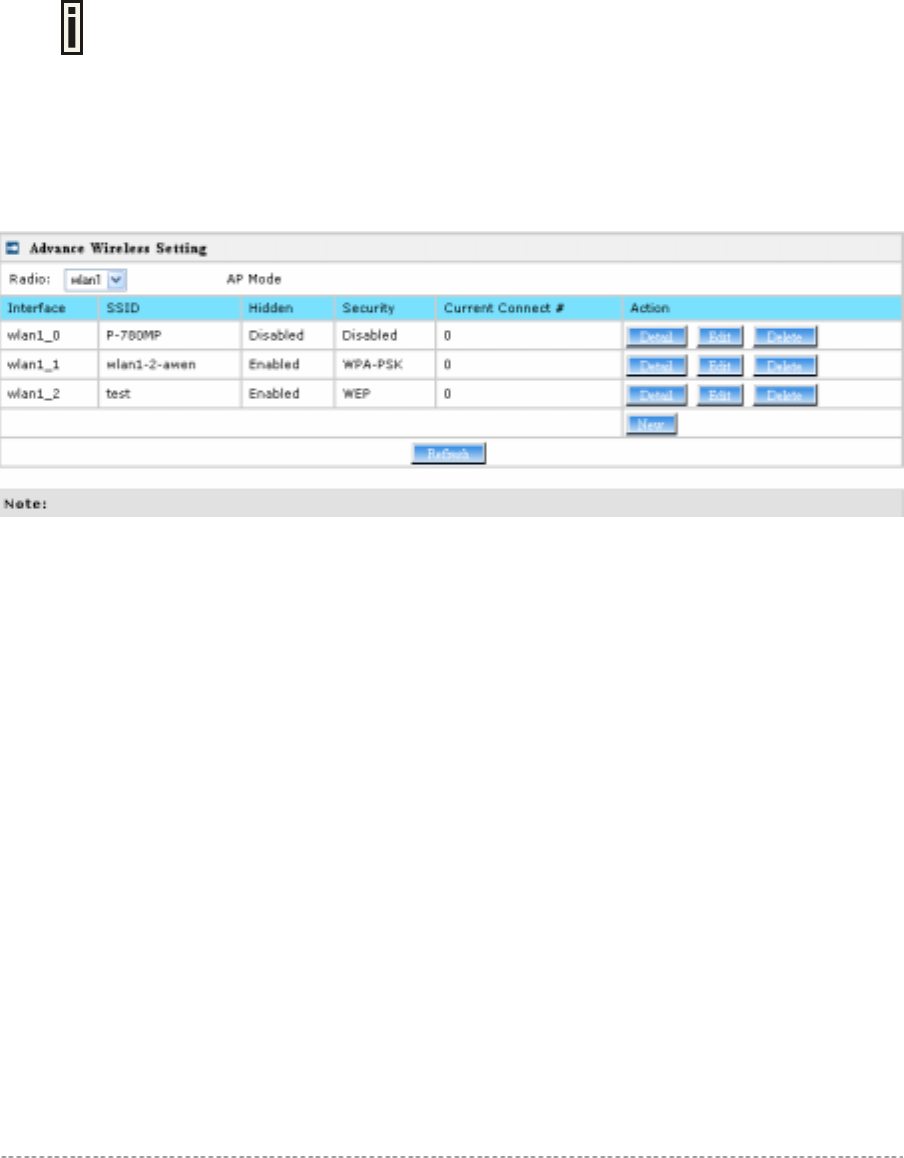
P-780 User’s Guide v1.2 February 7, 2005
Gemtek Systems Page 37 of 60
Wireless | Advance
P-780 supports Multiple BSSID (MBSSID) function. You can configure up to 16 BSSIDs per radio on
P-780 and assign different configuration settings to each BSSID. For wireless users, they can think P-
780 as single AP with multi service supporting, including different security policy, different VLAN ID,
different authentication etc. All the BSSIDs are active at the same time that means client devices can
associate to the access point for specific service. Use the Wireless | Advance menu to configure
properties related to Multiple BSSID, including configure SSID, Hidden SSID, VLAN, and Security for
each SSID.
Each BSSID can have its own SSID, In this case, Multiple BSSID is the same with
Multiple ESSID. Wireless users can think P-780 as multiple virtual APs, each
supporting different service, and connects one SSID for the special services.
Also, P-780 supports Bridge function, it can support up to 20 Bridge links per radio. Different bridge
link can use different WEP key index.
AP Mode:
Figure 36 – Advanced Wireless Setting (AP Mode)
Radio – specify which RF card (wlan1 or wlan2) is needed to be configured since P-780 has two
Dual-Band radios
Mode – specify the operation mode of P-780 (AP or Bridge)
Interface – Choose the specified MBSSID entry you want to configure. Each Interface maps to a
BSSID
Hidden – Show the status of Hidden SSID feature
Security – Show which security policy is used for this MBSSID entry
Current Connect # – Show the number of current wireless clients who are connecting with this
MBSSID
New – Create a new MBSSID entry
Detail – Show the detail information of this MBSSID entry
Edit – Edit the selected MBSSID entry you want to configure
Delete – Delete the selected MBSSID entry. When in AP mode, you can not delete the last entry
Clicking Detail, a similar page will be appears as below:
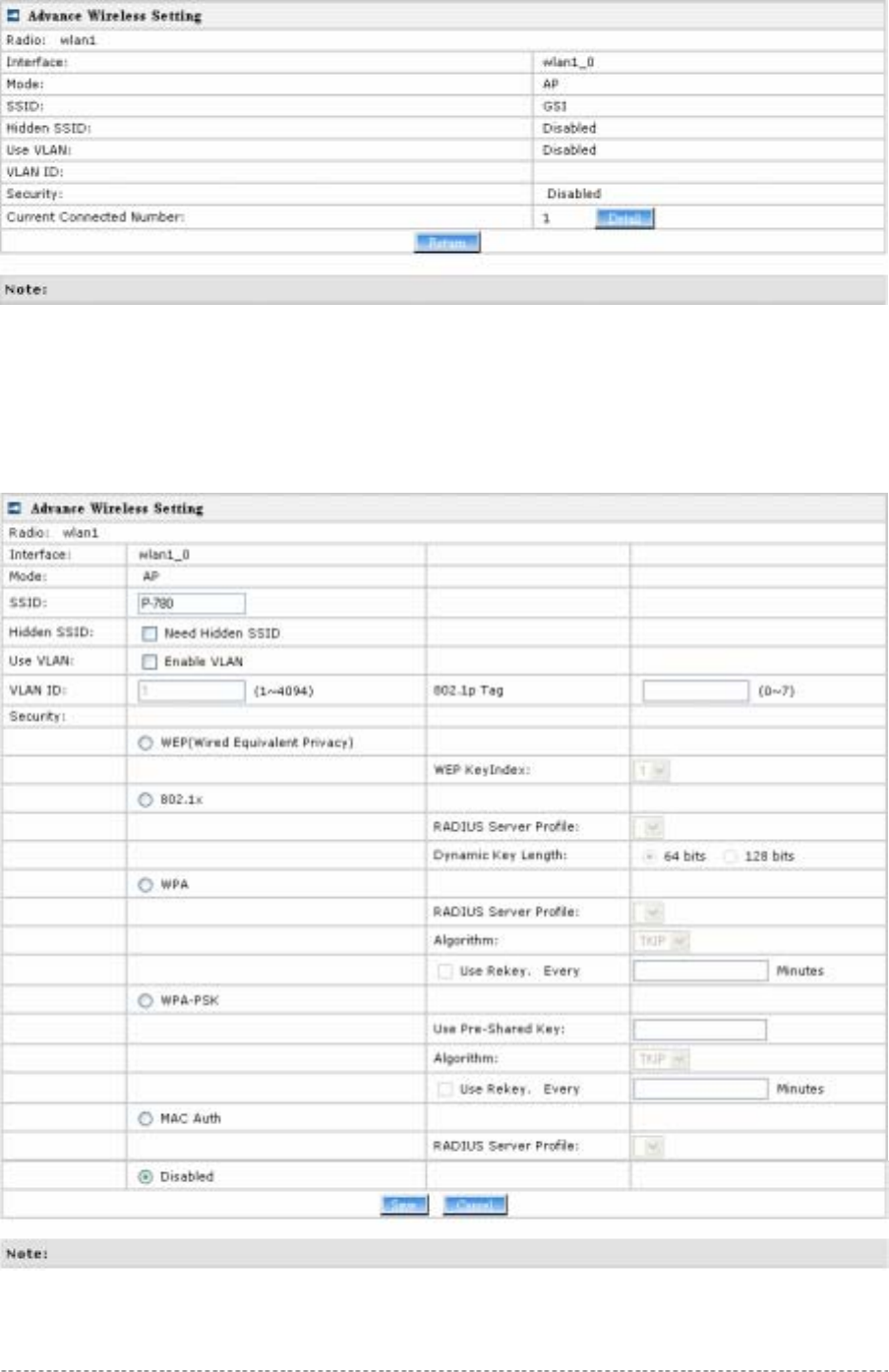
P-780 User’s Guide v1.2 February 7, 2005
Gemtek Systems Page 38 of 60
Figure 37 – Detail for MBSSID entry
Detail – Show the MAC address of current connected clients
Return – Return to the wireless advance settings page
Clicking New or Edit on AP mode, the settings of MBSSID entry appears:
Figure 38 – Multiple BSSID Setting
Radio – showing which RF card (wlan1 or wlan2) is being configured.

P-780 User’s Guide v1.2 February 7, 2005
Gemtek Systems Page 39 of 60
Mode – showing the current operation mode of P-780 (AP or Bridge).
Interface – showing the current MBSSID | Bridge link entry
SSID – a unique ID for your wireless network. It is case sensitive and must not exceed 32 characters.
The default SSID is "P-780" but you should change this to a personal wireless network name. The
SSID is important for clients when connecting to the access point. All client stations must have their
client SSID settings configured and must use the same SSID.
Each MBSSID entry (BSSID) can has its own SSID. And SSID can be same for
different BSSID
Hidden SSID – When enabled, the SSID of this Interface is invisible in the networks list while
scanning the available networks for wireless client (SSID is not broadcasted with its Beacons). When
disabled, the AP’s SSID is visible in the available network list [enabled/disabled]. By default the
Hidden SSID is disabled.
Use VLAN – When enabled, the outgoing packets from this SSID device will be tagged with VLAN ID
and 802.1p tag (If have).
VLAN ID – Configure VLAN ID for each Multiple SSID devices. Valid numbers are from 1 to 4094.
802.1p Tag – Configure 802.1p Tag for remote APC’s or Router’s QoS uses. Valid numbers are
from 0 to 7.
VLAN ID and 802.1p tag must cooperate with remote Router or APC.
Security – Specify the security policy.
WEP – When selected, the privacy of MSSID entry will be set to WEP (Wired Equivalent Privacy).
WEP Key Index – Select the default key Index to make it the Default key and encrypt the
data before being transmitted. All stations, including this MSSID Entry, always transmit data
encrypted using this Default Key. The key number (1,2,3,4) is also transmitted. The receiving
station will use the key number to determine which key to use for decryption. If the key value
does not match with the transmitting station, the decryption will fail. The key value is set in
Wireless | WEP web page.
802.1x – When selected, the MSSID entry will be configured as an 802.1x authenticator. It
supports multiple authentication types based on EAP (Extensible Authentication Protocol) like
EAP-TLS, EAP-TTLS, EAP-PEAP, EAP-SIM. The privacy will be configured as dynamic WEP.
RADIUS Server Profile – Select the default radius server name. If not, please configure
Network | RADIUS Servers Web page first.
Dynamic Key Length – Select the dynamic 64-bits / 128-bits encryption.
WPA – Wi-Fi Protected Access, When selected, the encrypt method will be WPA with RADIUS
Sever.
RADIUS Server Profile – The same as 802.1x.
Algorithm – Choose WPA algorithm (TKIP, AES).
Use ReKey – If not selected, indicates that Group Key will not be rekeyed. If selected, must
specify the time in minutes, after which the group key will be updated.
Every … minutes – Specify amount of minutes and WPA automatically will generate a new
Group Key.
WPA-PSK – When selected, the encrypt method will be WPA without RADIUS Server.
Use Pre-Shared Key – Specify more than 8 characters and less than 64 characters for WPA
with pre-shared key encryption.
Algorithm – The same as WPA.
Use Rekey – The same as WPA.
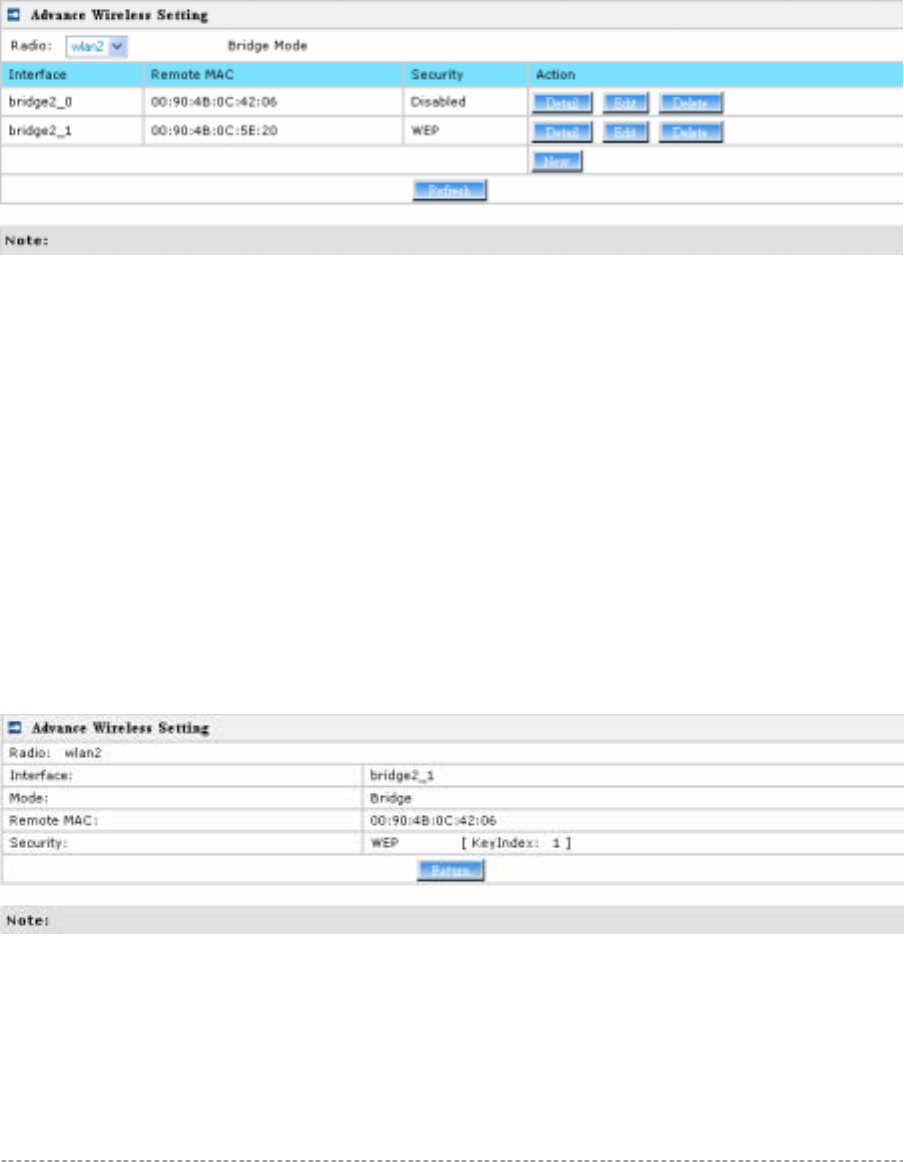
P-780 User’s Guide v1.2 February 7, 2005
Gemtek Systems Page 40 of 60
Every … minutes – The same as WPA.
MAC Auth – MAC authentication. When selected, the MAC address of username and password
will be passed to RADIUS server for PAP authentication when wireless client connects with P-780.
RADIUS Server Profile – The same as 802.1x.
Disabled – When selected, you don’t select any security policy.
Bridge Mode
Figure 39 – Advanced Wireless Setting (Bridge Mode)
Radio – specify which RF card (wlan1 or wlan2) is needed to be configured since P-780 has two
Dual-Band radios
Mode – specify the operation mode of P-780 (AP or Bridge)
Interface – Choose the specified Bridge link entry you want to configure.
Remote MAC – Specify the remote peer’s MAC address of this Bridge
Security – Specify which security policy is used
New – Create a new Bridge link entry
Detail – Show the detail information of this Bridge link entry
Edit – Edit the selected Bridge link entry you want to configure
Delete – Delete the selected Bridge link entry.
Clicking Detail, the similar page will be appears:
Figure 40 – Detail of one bridge entry
Clicking Edit for editing an existed bridge link or New for adding a new bridge link, you can see the
figure like this.
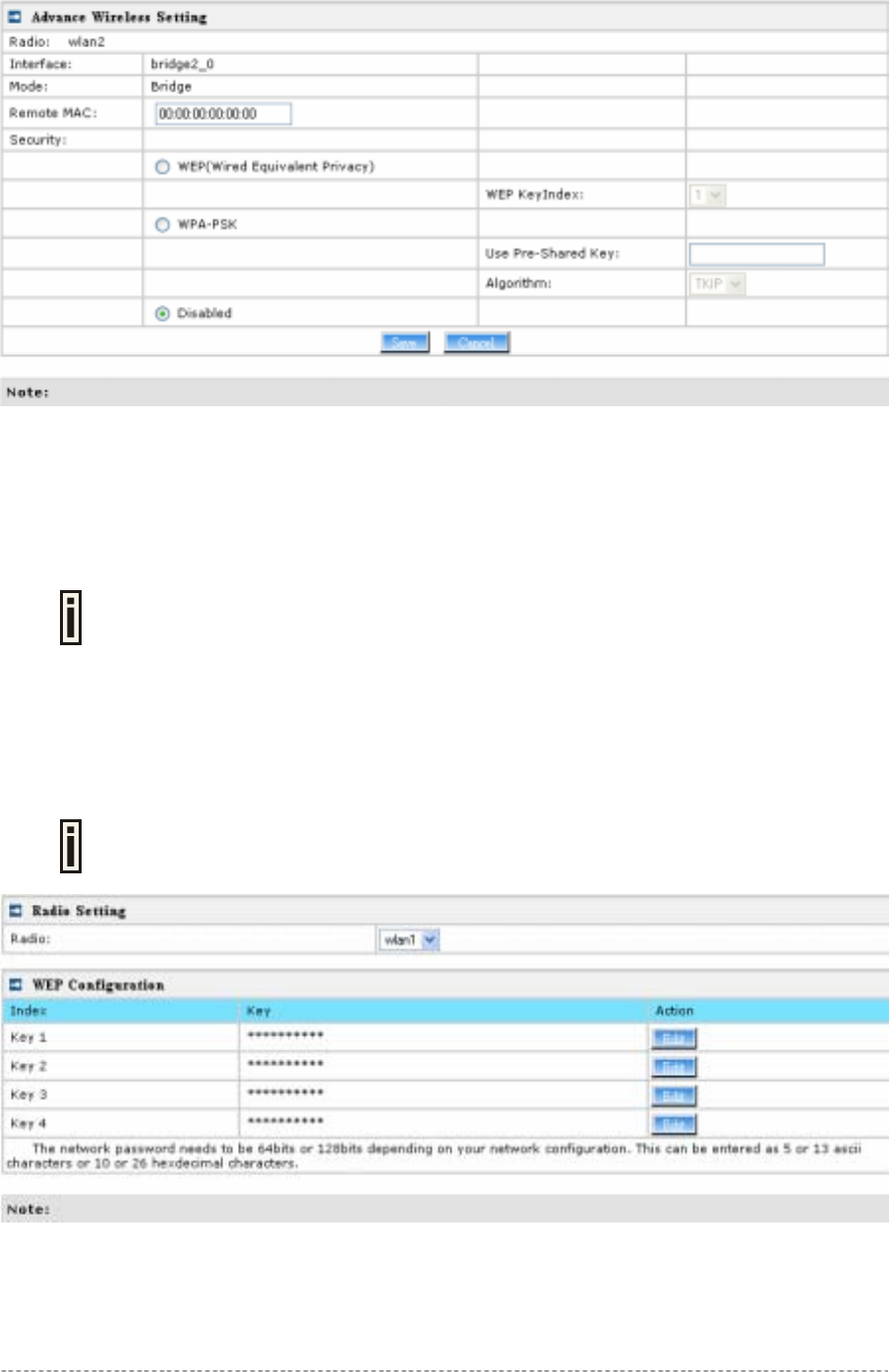
P-780 User’s Guide v1.2 February 7, 2005
Gemtek Systems Page 41 of 60
Figure 41 – Bridge Link Setting
Remote MAC – Add the remote peer’s MAC address you want to configure as a bridge link
Security – Specify WEP or WPA-PSK (TKIP or AES) is used for security policy. WPA-PSK or static
WEP can be used for encrypt each bridge link
Each Bridge link can have its own WEP key/keyIndex for encryption.
Only WEP can be used as security policy for Bridge links now. More enhanced
security policy is in developing.
By default, four WEP keys are all set to “aaaaa”. They can be modified in
Wireless | WEP.
Wireless | WEP
Use the Wireless | WEP menu to configure static WEP settings.
This menu only set static WEP key value related with 4 key indexes for each RF
card (wlan1 or wlan2). Enable or Disable static WEP is in the Wireless | Advance
menu.
Figure 42 – WEP Settings
Radio – specify which RF card (wlan1 or wlan2) is needed to be set.
Click Edit to edit the existing wepkey1 to wepkey4.
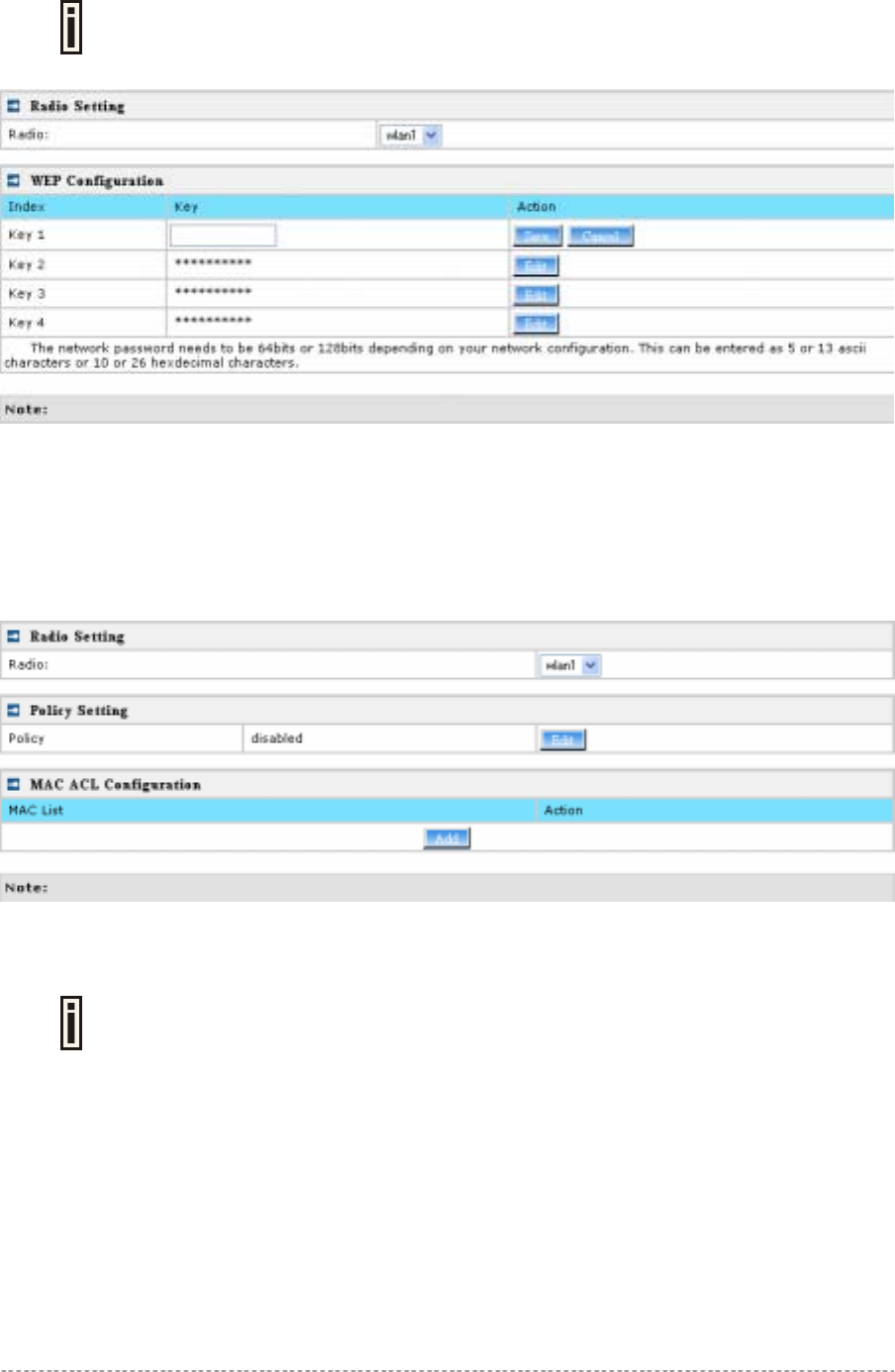
P-780 User’s Guide v1.2 February 7, 2005
Gemtek Systems Page 42 of 60
By default, four WEP keys are all set to “aaaaa”. They can be modified according to
real need.
Figure 43 – Edit WEP Key
Wireless | MAC ACL
Use the MAC ACL service to control the default access to the wireless interface of the P-780 or
define special access rules for mobile clients. Configure the ACL using the Wireless | MAC ACL menu:
Figure 44 – MAC ACL Service
Radio – Two wireless interfaces wlan1 and wlan2 can be selected for each radio’s MAC ACL rules.
Only AP mode has the MAC ACL service. The wireless interface whose mode is
Bridge hasn’t MAC ACL settings.
Policy Setting – click the edit button to choose Allow, Deny or disable the access control service on
device. By default the ACL service is disabled and all wireless clients connecting to the P-780 are
allowed (no ACL rules are applied to the wireless clients).
Select Allow means only the wireless clients whose MAC are listed in the MAC List would be
permitted to access this AP. Other wireless client cannot access this AP.
Select Deny means only the wireless clients whose MAC are listed in the MAC List would be
prevented from accessing. Other wireless clients can access this AP.
Select Disabled means no ACL service.
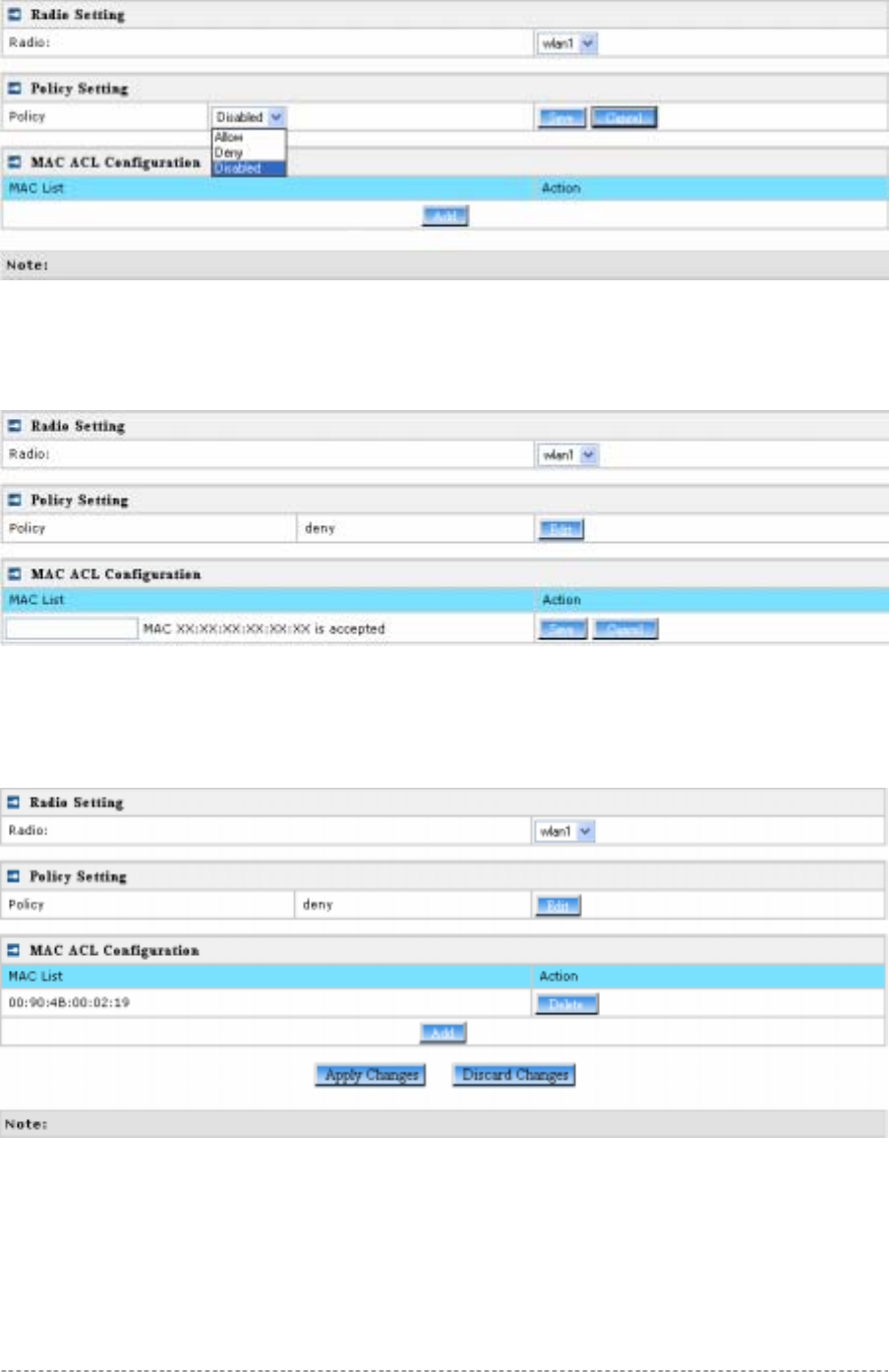
P-780 User’s Guide v1.2 February 7, 2005
Gemtek Systems Page 43 of 60
Figure 45 – MAC ACL settings
You must create MAC List to work with Policy setting. The access control list is based on the
network device’s MAC address. In the MAC ACL Configuration table, you only need to specify the
MAC address of wireless client. Click the Add button to create a new MAC entry:
Figure 46 – Add MAC entry
MAC Address – enter the physical address of the network device you need to (MAC address) The
format is a list of colon separated hexadecimal numbers (for example: 00:AA:A2:5C:89:56).
Save – click the button to save the new MAC entry.
Figure 47 – Apply or Discard MAC ACL Configuration Changes
Apply Changes – to save all changes made in the interface table at once.
Discard Changes – restore all previous values.
For such each change of settings, the P-780 needs to be restarted to apply all settings changes when
clicking Apply Changes. Request for reboot server appears:
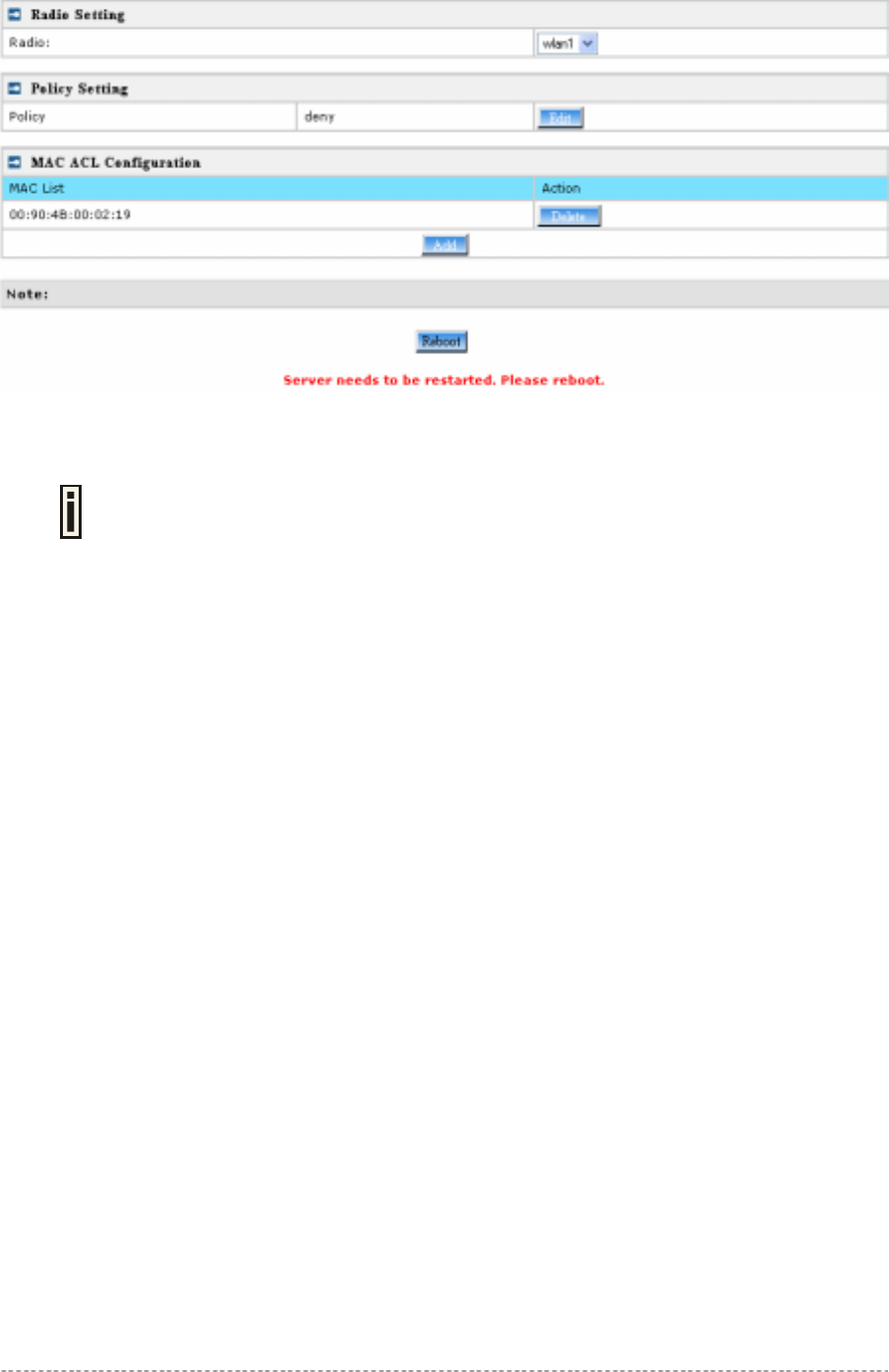
P-780 User’s Guide v1.2 February 7, 2005
Gemtek Systems Page 44 of 60
Figure 48 – Reboot Server
Reboot – Click the button to restart the server and apply the changes.
If there is no other setting needed to be modified, click the Reboot button for
applying all modifications.
And if there are still other setting modifications needed, go ahead to finish all
changes and then click Reboot button to restart and apply all settings together.
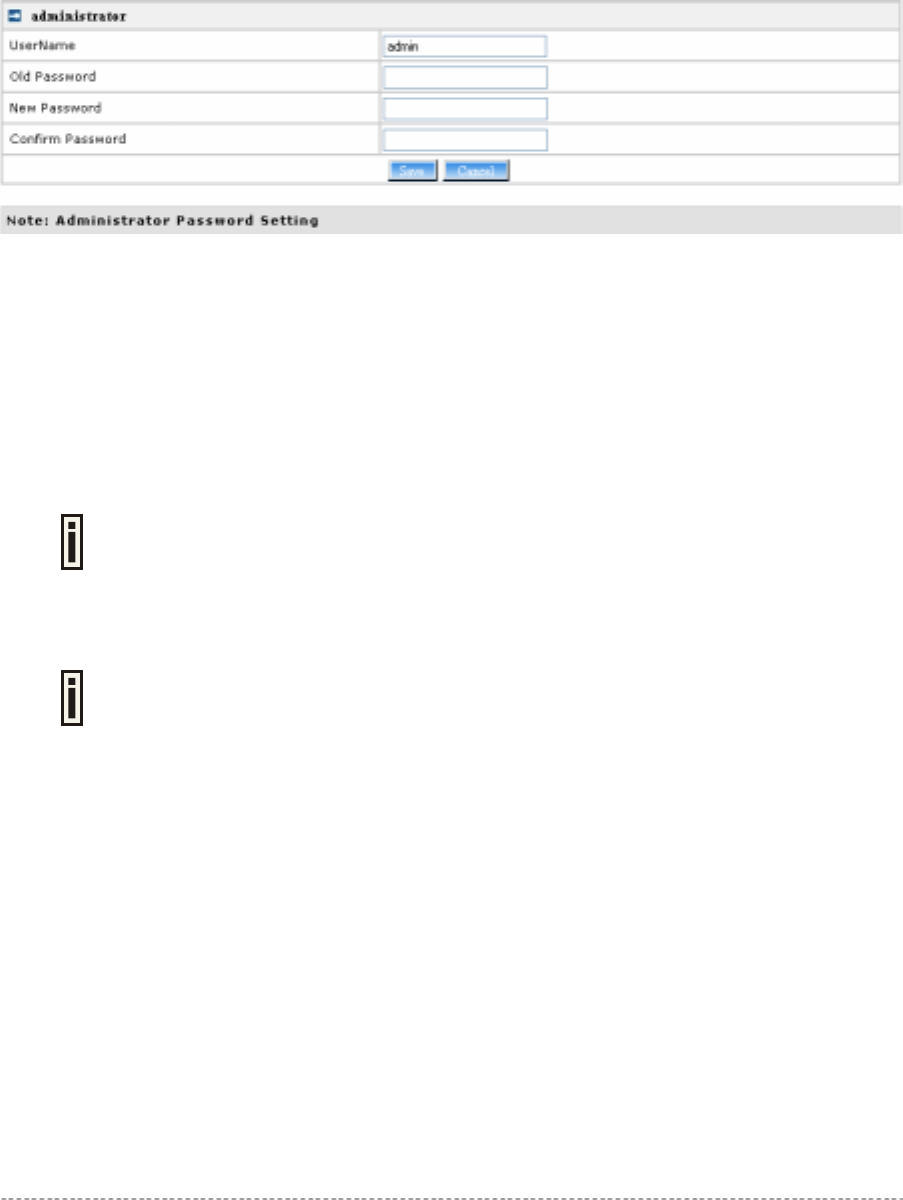
P-780 User’s Guide v1.2 February 7, 2005
Gemtek Systems Page 45 of 60
System
System | Security
Use the System | Security service to configure the name and password administrator:
Figure 49 – system security settings
User Name – administrator username for access to P-780 (e.g. web interface, CLI mode) [1-32
symbols, spaces not allowed].
Old Password – old password value.
New Password –new password value used for user authentication in the system [4-8 characters,
spaces not allowed].
Confirm Password – re-enter the new password to verify its accuracy.
Save – click to save new administrator settings.
Default administrator logon settings are:
User Name: admin
Password: admin01
Password length is from 4 to 8 characters.
System | SNMP
SNMP is the standard protocol that regulates network management over the Internet. To
communicate with SNMP manager you must set up the same SNMP communities and identifiers on
both ends: manager and agent.
Use the System | SNMP menu to change current SNMP configuration.
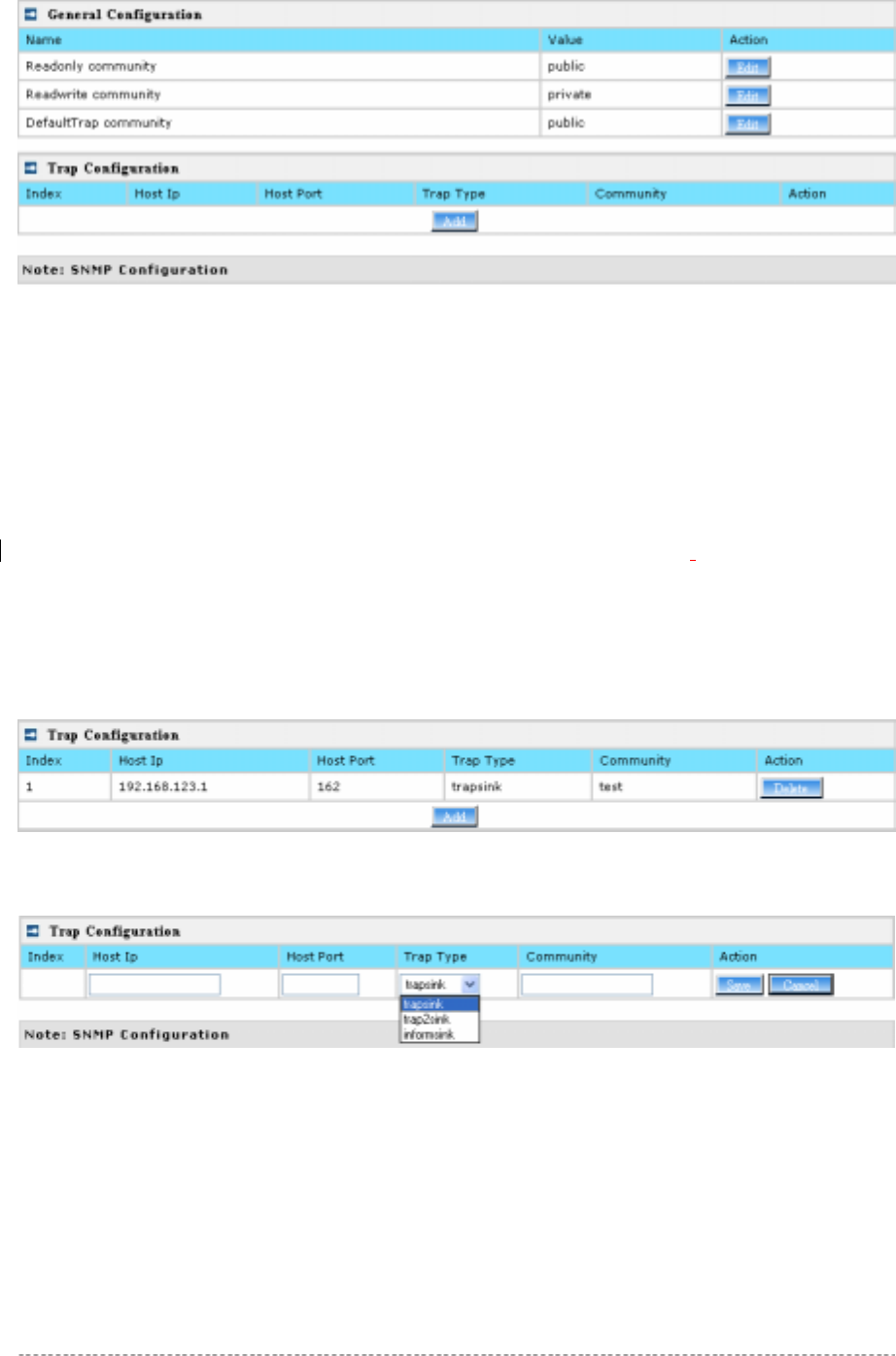
P-780 User’s Guide v1.2 February 7, 2005
Gemtek Systems Page 46 of 60
Figure 50 – SNMP settings
Readonly community – Community name is used in SNMP version 1 and version 2c. Read-only
(public) community allows reading values, but denies any attempt to change values [1-32 all ASCII
printable characters, no spaces].
Readwrite community – Community name is used in SNMP version 1 and version 2c. Read-write
(private) community allows to read and (where possible) change values [1-32 all ASCII printable
characters, no spaces].
Default Trap community – The default SNMP community name used for traps without specified
communities. The default community by most systems is "public". The community string must match
the community string used by the SNMP network management system (NMS) [1-32 all ASCII
printable characters, no spaces].
Trap Configuration Table:
You can configure your SNMP agent to send SNMP Traps (and/or inform notifications) under the
defined host (SNMP manager) and community name (optional).
Figure 51 – SNMP Trap table settings
Click Add to add a new SNMP manager or Delete to delete a specific SNMP manager. Clicking Add:
Figure 52 – Add SNMP Trap
Host IP – enter SNMP manager IP address [dots and digits].
Host Port – enter the port number the trap messages should be send through [number].
Trap Type – select trap message type [v1/v2/inform].
Community – specify the community name at a SNMP trap message. This community will be used in
trap messages to authenticate the SNMP manager. If not defined, the default trap community name
will be used (specified in the SNMP table) [1-32 all ASCII printable characters, no spaces].
Save – save all current settings
Cancel – restore the last settings
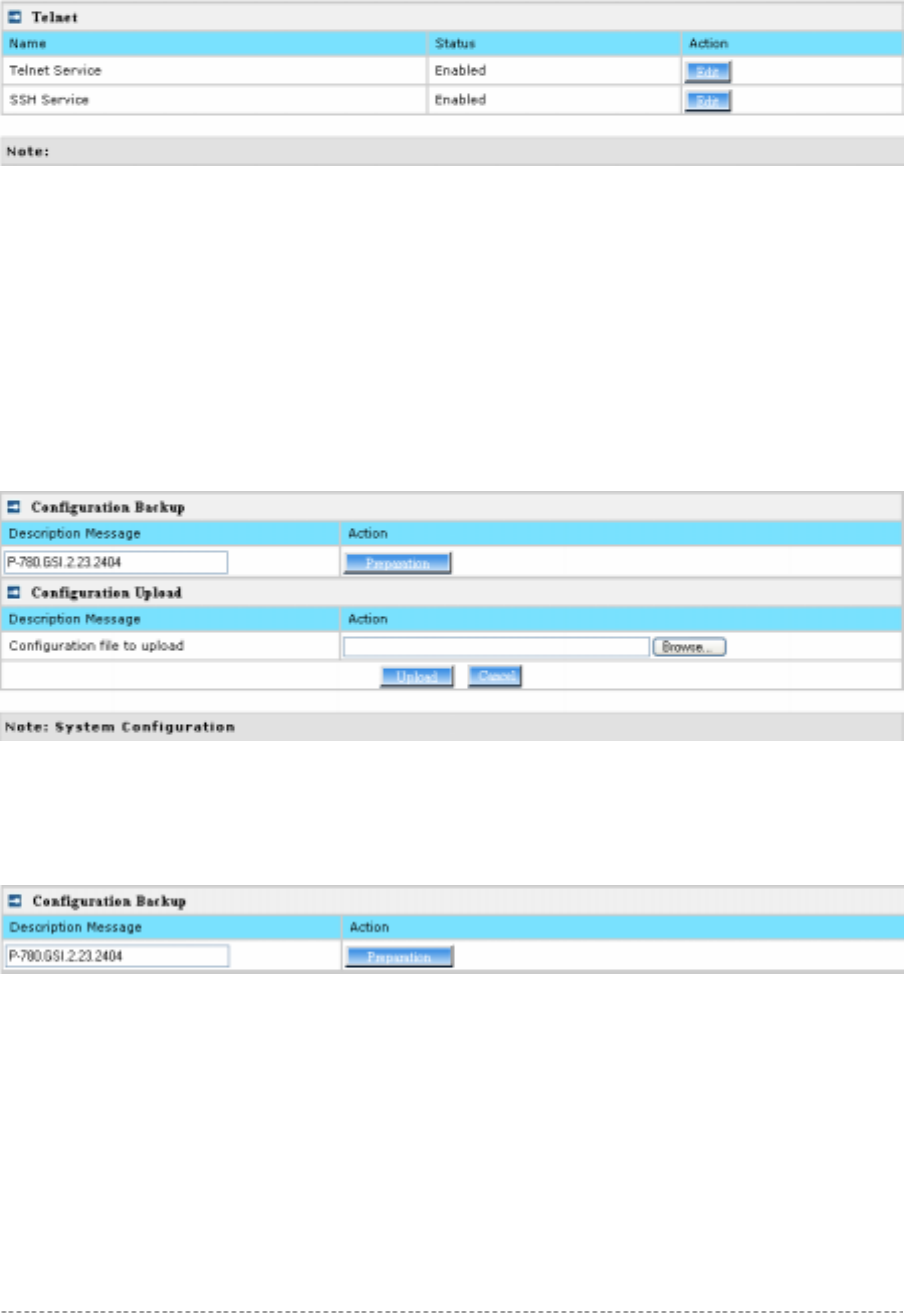
P-780 User’s Guide v1.2 February 7, 2005
Gemtek Systems Page 47 of 60
System | Telnet
Use System | Telnet menu to manage the telnet/SSH service of your P-780.
Figure 53 – System Configuration settings
Telnet Service – Enable or disable telnet service of P-780
SSH Service – Enable or disable SSH service of P-780.
The default of these two services are all Enabled. The current IETF SSH (SSHv2) is supported for
security of accessing P-780 via telnet/CLISH.
System | Configuration
Use the System | Configuration menu to configure such system utilities:
Backup – download current working system configuration for backup
Upload/Restore – upload system configuration for restore
Figure 54 – System Configuration settings
You can save your current device configuration file locally using the Backup menu under the System
| Configuration | Backup menu:
Figure 55 – Backup settings
Such device configuration is saved in the specific format file (.cfg).
Description Message shows the current version of firmware.
Click the Preparation button to start saving the configuration file.
Click the Download button to download current working configuration into your local PC.
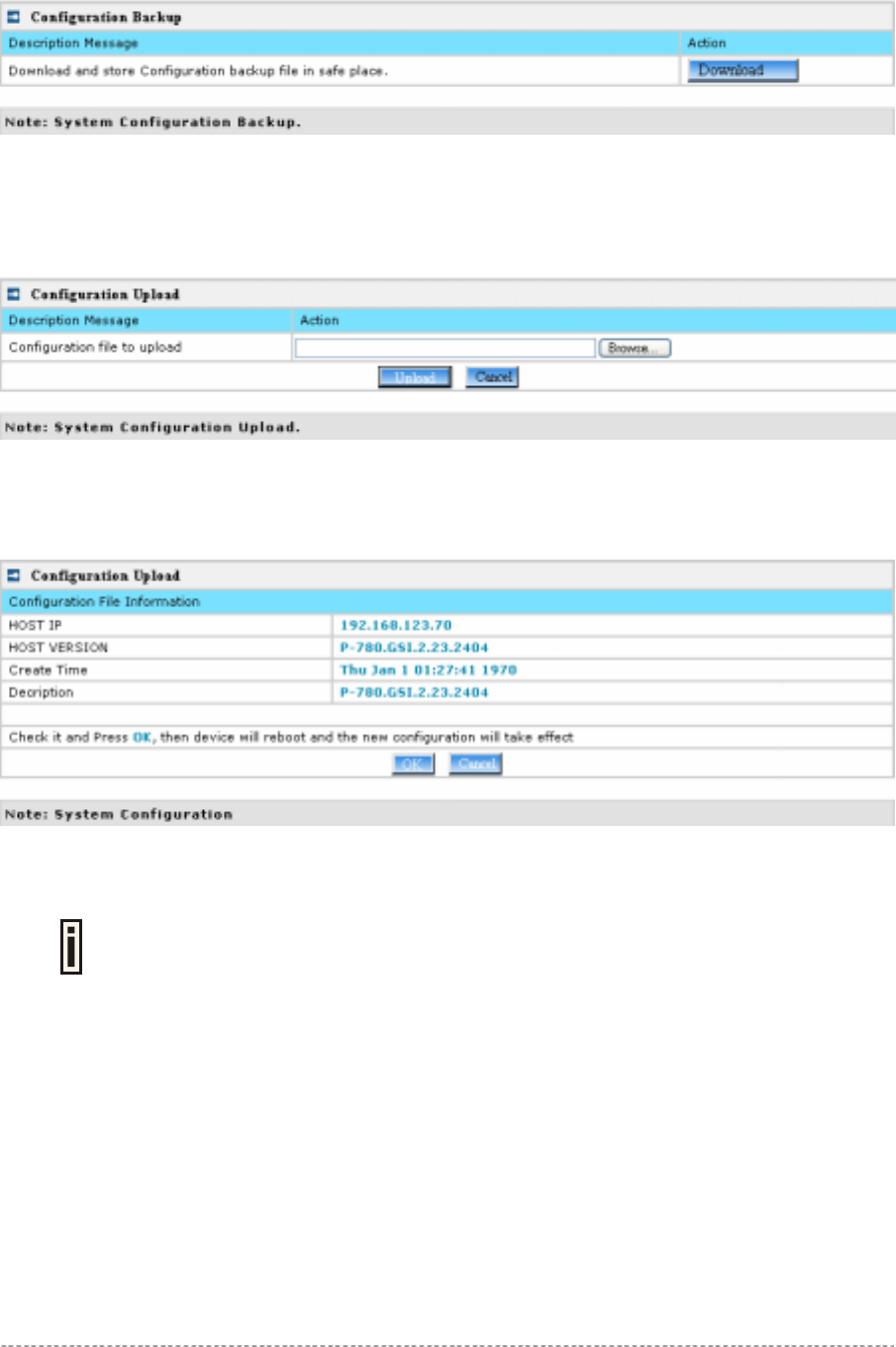
P-780 User’s Guide v1.2 February 7, 2005
Gemtek Systems Page 48 of 60
Figure 56 – Download system configuration
You can upload saved configuration file any time you want to restore this configuration to the device
by using the Browse button Select the configuration file and upload it on the device:
Figure 57 – Configuration Upload/Restore
Click Upload for upload the specified configuration and then the similar UI appears
Figure 58 – configuration information
HOST IP – show the IP address in the configuration file that needs to upload.
Please remember this IP address for accessing P-780 after the configuration file is
uploaded.
HOST VERSION – show the firmware version in the configuration file that needs to upload.
OK – click the button to apply configuration setting to the device.
If everything is right, click OK button for upload/restore.
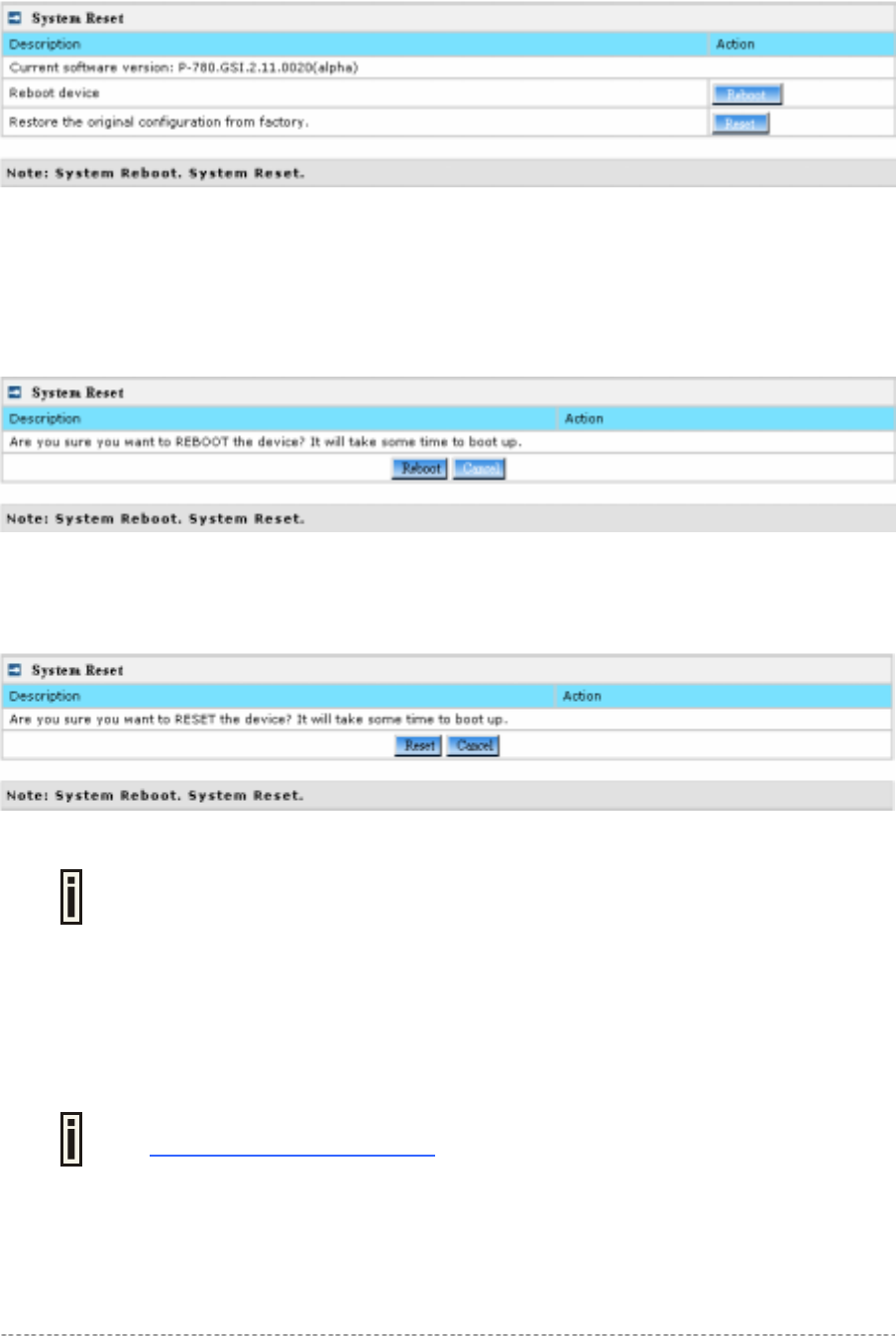
P-780 User’s Guide v1.2 February 7, 2005
Gemtek Systems Page 49 of 60
System | Reset
Figure 59 – System Reset setting
Reboot – Reboot the device
Reset – Reset System to Factory Defaults
To reboot the device, click Reboot and then the below appears to make sure:
Figure 60 – Reboot the device
To reset device to factory defaults, click Reset on Figure 48 and then the below appears to make sure:
Figure 61 – Reset the device
Please note that all settings including the administrator settings will be set back to
the factory default when Reset is selected.
System | Upgrade
Check for new product updates at the Gemtek Systems website:
http://www.gemtek-systems.com
Upload – Update your device firmware.
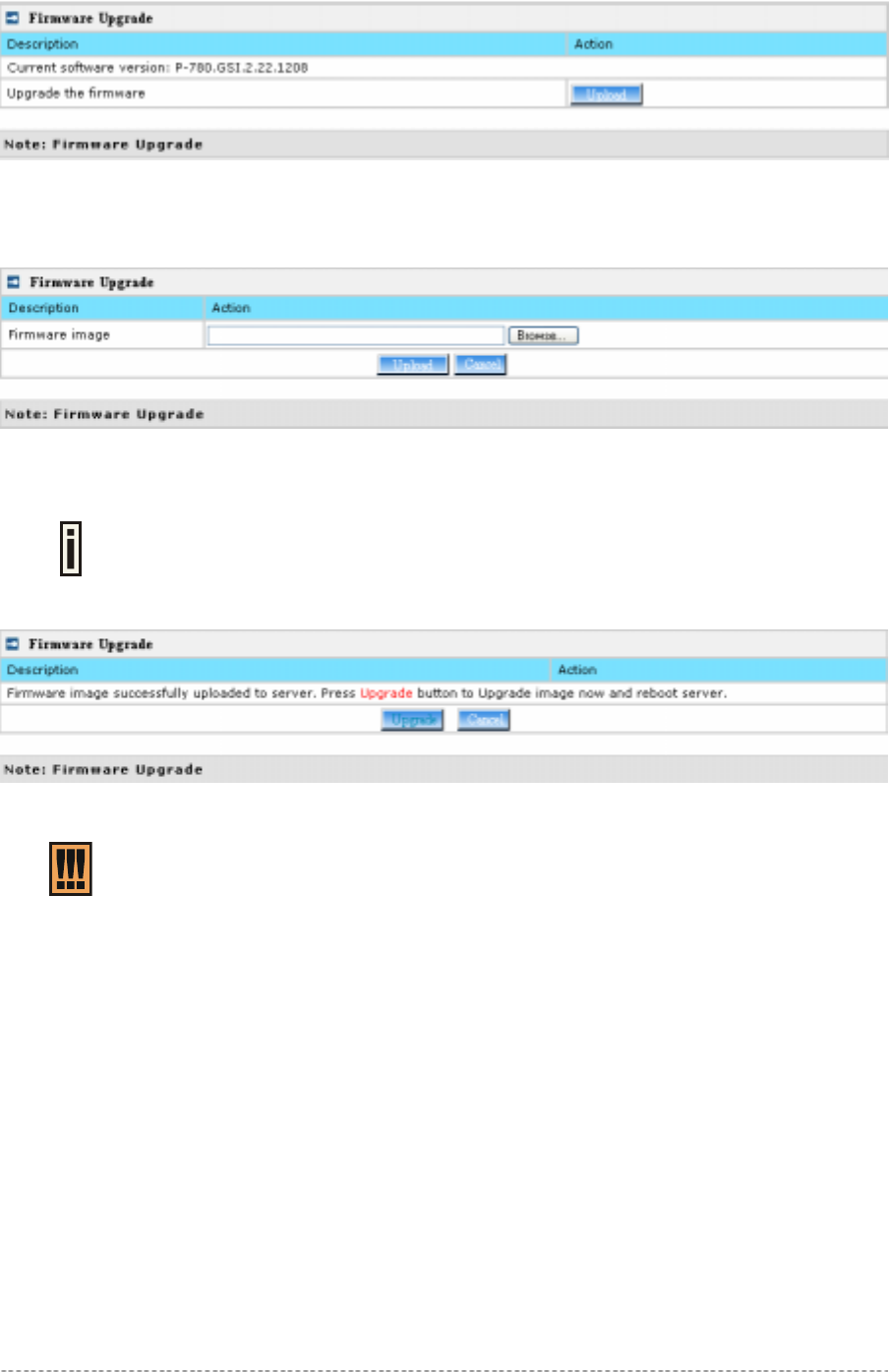
P-780 User’s Guide v1.2 February 7, 2005
Gemtek Systems Page 50 of 60
Figure 62 – Firmware Upgrade
Click the Upload and then the follow appears. Specify the full path to the new firmware image and
click the Upload button:
Figure 63 – Firmware Upgrade
To flash the uploaded firmware image to upgrade the firmware is done by click the Upgrade button.
Please make sure the firmware is correct for P-780. Otherwise the upgrade will be
failed.
Figure 64 – Device Statistics
Do not switch off and do not disconnect the P-780 from the power supply during the
firmware update process because the device could be damaged. It is best to use
the Ethernet connection (not wireless) for the firmware update process.

P-780 User’s Guide v1.2 February 7, 2005
Gemtek Systems Page 51 of 60
A) Specification
Wireless
Standard IEEE 802.11b(DSSS), IEEE 802.11g(OFDM) and IEEE 802.11a(OFDM)
Data Rate 802.11a: 54,48,36,24,18,12,9,6Mbps;802.11g:
54,48,36,24,12,9,6,11,5,5,2,1Mbps (auto fall back)
Transmit Power
(adjustable RF power)
Max. 17 dBm ± 1.5dBm @6~24Mbps
Max. 13 dBm ± 1.5dBm @54Mbps (Maximum power will vary by channel,
rate and regulatory domain)
Antennas two N type connectors
Encryption WPA(TKIP and CCMP-AES), WEP64, WEP128
Bridge Up to 20 bridge links
Interface
LAN 10/100Mb Ethernet, auto sensing, RJ-45
WLAN1 N-type Connector
WLAN2 N-type Connector
Management
Interfaces HTTPs, Secure Telnet(SSHv2), SNMP
Software Update Remote software update via HTTPs
Reset Remote restore factory default
Physical Specification
Dimension 180 mm x 160 mm x 58 mm
Weight 1.2kg
Environment Specification
Temperature Humidity
Operating -40 to 70°C 95%, non-condensing
Power Supply
POE 48V, IEEE802.3af-2003 compliance
LEDs
3 LEDs LAN, WLAN1, WLAN2
Warranty
1 years
Package Contents
P-780 Dual-Band Outdoor Access Point Mounting Kit including SCREW
Printed warranty note, release note,
warning card
CD with P-780 Firmware , Kickstart Utility and
User manual(*.pdf)
Omni Dual-Band Antenna(A-807) * 2 Waterproof tape
Waterproof RJ45 Straight Plug
Related Products
Appendix

P-780 User’s Guide v1.2 February 7, 2005
Gemtek Systems Page 52 of 60
Controllers: G-6000/G-4200 Public Access Controller
Access Points: P-520 54Mb Operator Access Point P-560 54Mb Hotspot-in-a-Box
Client Adapters: T-511 54Mb High Gain Smart Ethernet Client (2.4 GHz)
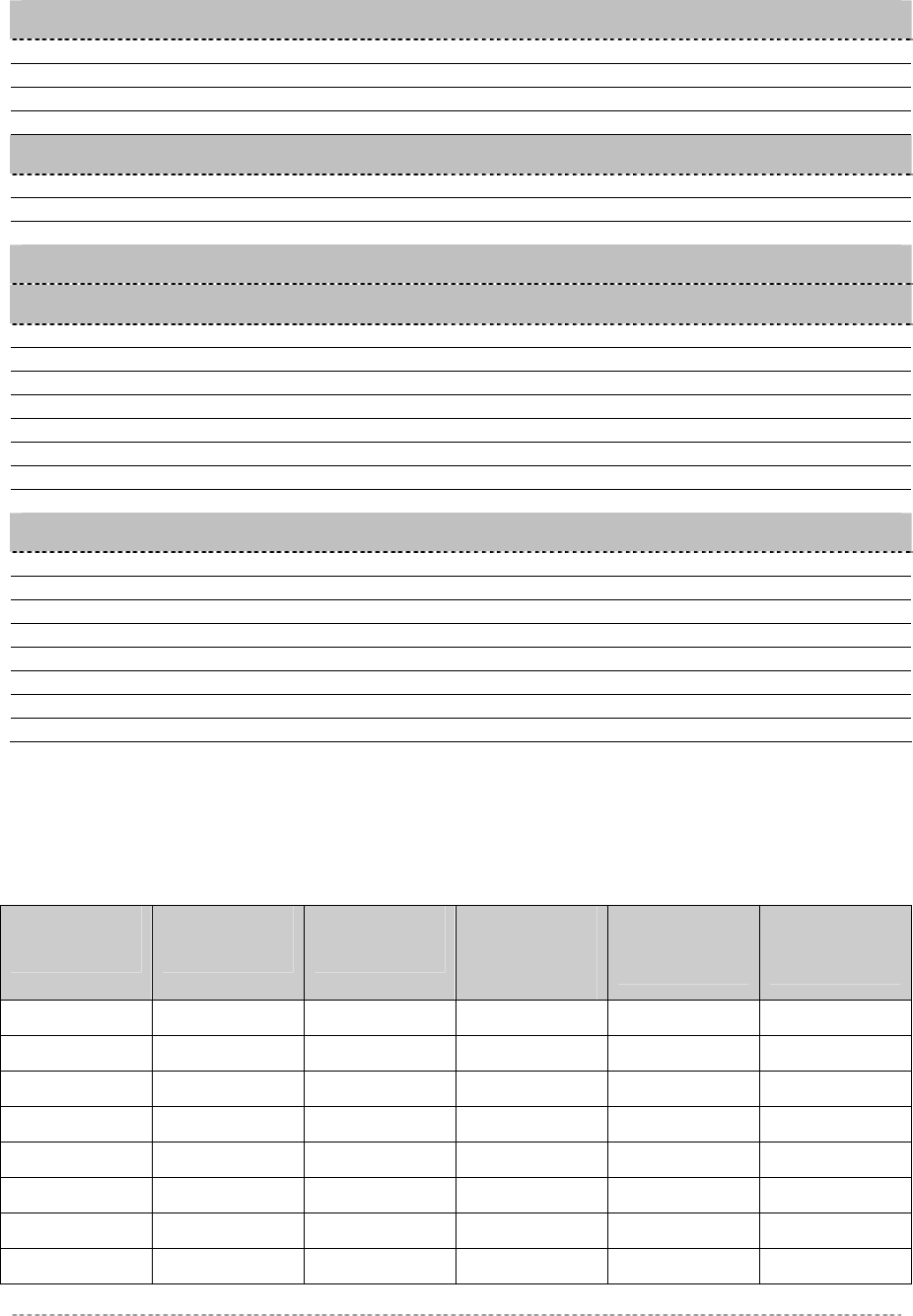
P-780 User’s Guide v1.2 February 7, 2005
Gemtek Systems Page 53 of 60
B) Factory Defaults for the P-780
General Configuration Settings
Administrator Username admin
Administrator Password admin01
Get Community Public
Set Community Private
Network Configuration Settings
IP address (static IP) 192.168.2.2
Subnet mask 255.255.255.0
Gateway 0.0.0.0
Wireless Configuration Settings
RF Card 1(WLAN1)
Default Mode 11g Access Point
Regulatory Domain World
SSID P-780
Default channel 11
RTS Threshold 2347 bytes
Authentication Type Open System
Encryption Off
RF Card 2(WLAN2)
Default Mode 11a Access Point
Regulatory Domain World
SSID P-780
Default channel 60
RTS Threshold 2347 bytes
Authentication Type Open System
Encryption Off
C) Regulatory Domain/Channels/Power
Channels and Maximum output power for the P-780 11g radio:
Channels
Identifiers Frequency in
MHz USA, Canada
(FCC) European
Union
(CE/ETSI)
WORLD
(CE&FCC) Japan
(TELEC)
1 2412 • • • •
2 2417 • • • •
3 2422 • • • •
4 2427 • • • •
5 2432 • • • •
6 2437 • • • •
7 2442 • • • •
8 2447 • • • •

P-780 User’s Guide v1.2 February 7, 2005
Gemtek Systems Page 54 of 60
9 2452 • • • •
10 2457 • • • •
11 2462 • • • •
12 2467 — • — •
13 2472 — • — •
14 2484 — — — —
Maximum output Power 16dBm 14dBm 14dBm 14dBm
Channels and Maximum power for the P-780 11a radio:
Channels
Identifiers Frequency in
MHz USA, Canada
(FCC) European
Union
(CE/ETSI)
WORLD
(CE/FCC) Japan
(TELEC)
U-NII lower band (5150 – 5250 MHz)
34 5170 — — — •
36 5180 • • • —
38 5190 — — — •
40 5200 • • • —
42 5210 — — — •
44 5220 • • • —
46 5230 — — — •
48 5240 • • • —
Maximum Output Power 12 dBm 17 dBm 15 dBm 15 dBm
U-NII middle band (5250 – 5350 MHz)
52 5260 • • • —
56 5280 • • • —
60 5300 • • • —
64 5320 • • • —
Maximum Output Power 12 dBm 17 dBm 17 dBm —
U-NII upper band ( 5725 – 5875 MHz)
149 5745 • — — —
153 5765 • — — —
157 5785 • — — —
161 5805 • — — —
165 5825 — — — —
Maximum Output Power 14 dBm 17 dBm 17 dBm —

P-780 User’s Guide v1.2 February 7, 2005
Gemtek Systems Page 58 of 60
F) Location ID and ISO Country Codes
This list states the country names (official short names in English) in alphabetical order as given in
ISO 3166-1 and the corresponding ISO 3166-1-alpha-2 code elements.
It lists 239 official short names and code elements.
Location
ID Country Location
ID Country
AF Afghanistan LI Liechtenstein
AL Albania LT Lithuania
DZ Algeria LU Luxembourg
AS American Samoa MO Macao
AD Andorra MK Macedonia, the former Yugoslav
republic of
AO Angola MG Madagascar
AI Anguilla MW Malawi
AQ Antarctica MY Malaysia
AG Antigua and Barbuda MV Maldives
AR Argentina ML Mali
AM Armenia MT Malta
AW Aruba MH Marshall islands
AU Australia MQ Martinique
AT Austria MR Mauritania
AZ Azerbaijan MU Mauritius
BS Bahamas YT Mayotte
BH Bahrain MX Mexico
BD Bangladesh FM Micronesia, federated states of
BB Barbados MD Moldova, republic of
BY Belarus MC Monaco
BE Belgium MN Mongolia
BZ Belize MS Montserrat
BJ Benin MA Morocco
BM Bermuda MZ Mozambique
BT Bhutan MM Myanmar
BO Bolivia NA Namibia
BA Bosnia and Herzegovina NR Nauru
BW Botswana NP Nepal
BV Bouvet island NL Netherlands
BR Brazil AN Netherlands Antilles
IO British Indian ocean territory NC New Caledonia
BN Brunei Darussalam NZ New Zealand
BG Bulgaria NI Nicaragua
BF Burkina Faso NE Niger

P-780 User’s Guide v1.2 February 7, 2005
Gemtek Systems Page 59 of 60
BI Burundi NG Nigeria
KH Cambodia NU Niue
CM Cameroon NF Norfolk island
CA Canada MP Northern Mariana islands
CV Cape Verde NO Norway
KY Cayman islands OM Oman
CF Central African republic PK Pakistan
TD Chad PW Palau
CL Chile PS Palestinian territory, occupied
CN China PA Panama
CX Christmas island PG Papua new guinea
CC Cocos (keeling) islands PY Paraguay
CO Colombia PE Peru
KM Comoros PH Philippines
CG Congo PN Pitcairn
CD Congo, the democratic republic of the PL Poland
CK Cook islands PT Portugal
CR Costa Rica PR Puerto Rico
CI Côte d'ivoire QA Qatar
HR Croatia RE Réunion
CU Cuba RO Romania
CY Cyprus RU Russian federation
CZ Czech republic RW Rwanda
DK Denmark SH Saint Helena
DJ Djibouti KN Saint Kitts and Nevis
DM Dominica LC Saint Lucia
DO Dominican republic PM Saint Pierre and Miquelon
EC Ecuador VC Saint Vincent and the grenadines
EG Egypt WS Samoa
SV El Salvador SM San Marino
GQ Equatorial guinea ST Sao tome and Principe
ER Eritrea SA Saudi Arabia
EE Estonia SN Senegal
ET Ethiopia SC Seychelles
FK Falkland islands (malvinas) SL Sierra Leone
FO Faroe islands SG Singapore
FJ Fiji SK Slovakia
FI Finland SI Slovenia
FR France SB Solomon islands
GF French Guiana SO Somalia
PF French Polynesia ZA South Africa

P-780 User’s Guide v1.2 February 7, 2005
Gemtek Systems Page 60 of 60
TF French southern territories GS South Georgia and the south
sandwich islands
GA Gabon ES Spain
GM Gambia LK Sri Lanka
GE Georgia SD Sudan
DE Germany SR Suriname
GH Ghana SJ Svalbard and Jan Mayan
GI Gibraltar SZ Swaziland
GR Greece SE Sweden
GL Greenland CH Switzerland
GD Grenada SY Syrian Arab republic
GP Guadeloupe TW Taiwan, province of china
GU Guam TJ Tajikistan
GT Guatemala TZ Tanzania, united republic of
GN Guinea TH Thailand
GW Guinea-Bissau TL Timor-leste
GY Guyana TG Togo
HT Haiti TK Tokelau
HM Heard island and McDonald islands TO Tonga
VA Holy see (Vatican city state) TT Trinidad and Tobago
HN Honduras TN Tunisia
HK Hong Kong TR Turkey
HU Hungary TM Turkmenistan
IS Iceland TC Turks and Caicos islands
IN India TV Tuvalu
ID Indonesia UG Uganda
IR Iran, Islamic republic of UA Ukraine
IQ Iraq AE United Arab emirates
IE Ireland GB United kingdom
IL Israel US United states
IT Italy UM United states minor outlying islands
JM Jamaica UY Uruguay
JP Japan UZ Uzbekistan
JO Jordan VU Vanuatu
KZ Kazakhstan Vatican city state see holy see
KE Kenya VE Venezuela
KI Kiribati VN Viet nam
KP Korea, democratic people's republic
of VG Virgin islands, British
KR Korea, republic of VI Virgin islands, u.s.
KW Kuwait WF Wallis and Futuna
KG Kyrgyzstan EH Western Sahara

P-780 User’s Guide v1.2 February 7, 2005
Gemtek Systems Page 61 of 60
LA Lao people's democratic republic YE Yemen
LV Latvia YU Yugoslavia
LB Lebanon Zaire see Congo, the democratic
republic of the
LS Lesotho ZM Zambia
LR Liberia ZW Zimbabwe
LY Libyan Arab Jamahiriya

Professional installation instruction
1. Installation personal
This product is designed for specific application and needs to be installed by a
qualified personal who has RF and related rule knowledge. The general user shall
not attempt to install or change the setting.
2. Installation location
The product shall be installed at a location where the radiating antenna can be kept
20 cm from nearby person in normal operation condition to meet regulatory RF
exposure requirement.
3. External antenna,
Use only the antennas which have been approved by Gemtek. The non-approved
antenna(s) may produce unwanted spurious or excessive RF transmitting power
which may lead to the violation of FCC limit and is prohibited.
4. Installation procedure
Please refer to user’s manual for the detail.
5. Warning
Please carefully select the installation position and make sure that the final output
power does not exceed the limit set force in US Rule CFR 47 part 15 section
15.247. and 15.407 The violation of the rule could lead to serious federal penalty.